#march 30 2018
Text


march 30, 2018 | six years ago today
the ‘delicate’ vertical video was released on spotify and taylor also posted it to instagram
during it, she teased ‘lover’ with her nail colors and wore the vs angel ring as well as the matching diamond eye ring she has with karlie kloss
#march 30 2018#march 30#2018#delicate#karlie kloss#kaylor#vs angel ring#eye ring#eye theory#music videos#delicate music video#songs and albums#lover the album#gaylor throwbacks#gaylor#gaylor swift#lgbetty
69 notes
·
View notes
Text
youtube
La classe Fi Las Vegas
Mazalda - Topic
· Sofiane Saidi
· Mazalda El Ndjoum
℗ Airfono / Carton Records
Released on: 2018-03-30
Lyricist: Sofiane Saidi
Composer: Adrien Spirli
Composer: Lucas Spirli
#La classe Fi Las Vegas#Sofiane Saidi#Mazalda#Mazalda El Ndjoum#℗ Airfono / Carton Records#March 30 2018#March 30#2018#2010s#Adrien Spirli#Lucas Spirli#Youtube
1 note
·
View note
Text




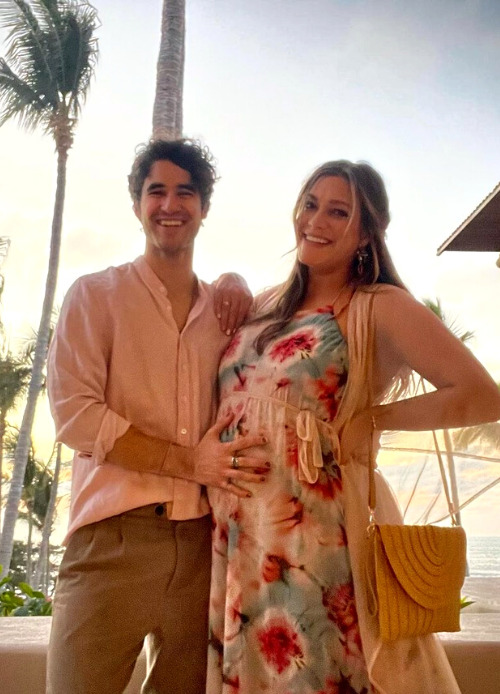












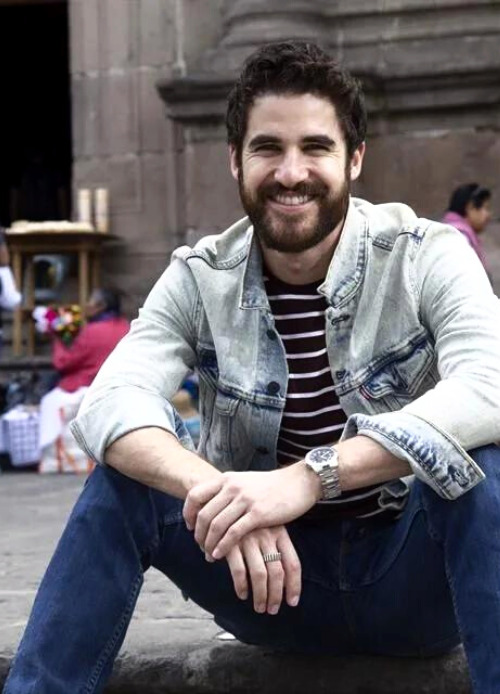





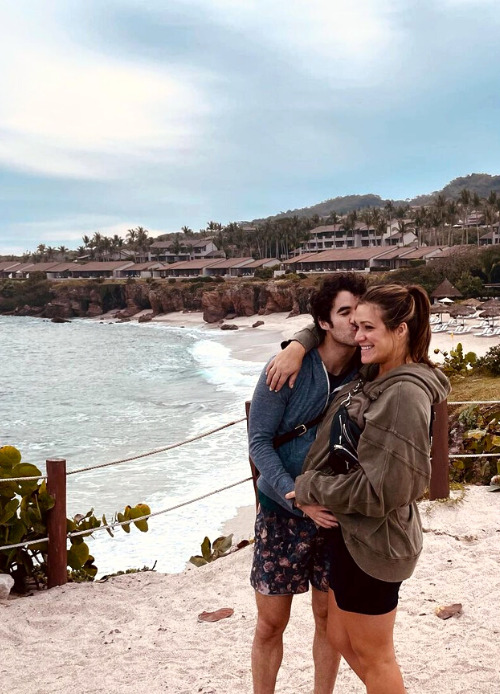




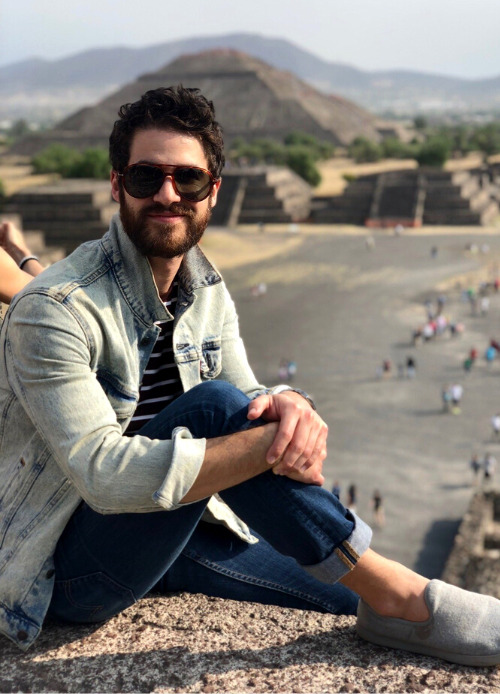

Darren Criss + México🇲🇽
#darren criss#mia criss#mia swier#darren plus#darren in mexico#🇲🇽#darren criss @ plaza condesa#darren criss @ frontón méxico#reforma gente photoshoot#frontón méxico photoshoot#baby moon#mexico city#march 2018#punta mita#teotihuacan#arms💪#🇲🇽🎉。+. ݁ ˖*。#really#long post#had to take advantage of the 30 image limit on web#cuz there are a lot of pics#mancandykings#q#please do not repost
21 notes
·
View notes
Photo

iamaly: Adventure ready in New Zealand thanks to @madewell 🎒
3 notes
·
View notes
Text
fuck it transition timeline
I was originally gonna wait until July to do this because that'll mark 3 years on E but I feel like now's a good time all things considered
With that out of the way lets start from the beginning AKA freshman year (AKA 2018)

This was on my way to band camp which is why you can see my trombone in the background (random fact: that was the only year I got to do marching band and our show was "the music of harry potter". yeah irony's a bitch ain't she?)
Graduation picture featuring the bestest boi Jinn :3

This pic is from 2020 because I switched to online and finished high school early out of spite (I was 16 here if you were wondering)
Now then this is from 2021 and was taken only about a week before I started hrt when I was 17

The lake in the background is Lake Superior in case you were wondering. Me and my mother were all the way up on the Keweenaw Peninsula for my family's 4th of July party held at the family farm
Moving on from that I started HRT on July 22 2021 (the appointment was at 9:30 am and I took my first dose at 7:42 pm yes I kept track)

This was taken like a half hour after my first dose (I actually don't really like this pic that much but I'm including it because it is important)
Fast forward from that a year to 2022 when I was 18 and here are a few pics of me around then one of which again featuring best boi Jinn

(it was windy out that day and he tried to bite me immediately after this lmao)



I've never been particularly good at taking selfies lmao
That brings us to now. I've been on hrt for about 2.5 years now if my math is correct. I'm pretty much living full time as a woman, started laser hair removal a couple months ago (next apt is actually tomorrow lol), and I'm working on getting my legal name and gender changed. It's been a long ride thus far and I don't really plan on stopping anytime soon so yeah here ya go




So that's it! At least thus far lol
also fuck photomatt 🚗🔨💥
#Trans#Transgender#transition timeline#queer#lesbian#long post#I might have gotten a little bit carried away there lol#🚗🔨💥#idgaf if this is cheesy or whatever#I kinda like how it turned out#took too long to gather all these together#I like never take pics of myself#my camera roll is just 4000 memes
549 notes
·
View notes
Text
3,500-year-old burial of Nubian woman reveals 1 of world's earliest known cases of rheumatoid arthritis
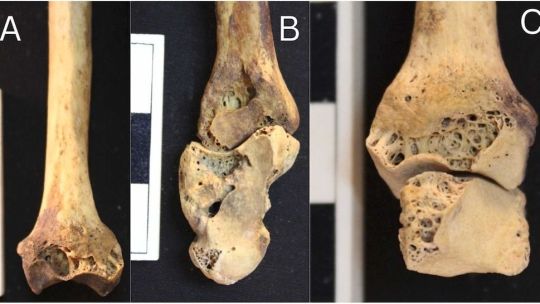
The 3,500-year-old pockmarked skeleton of an ancient Nubian woman could be one of the earliest known cases of rheumatoid arthritis in the world, scientists say.
Archaeologists discovered the woman's skeletal remains in 2018 while conducting excavations at a cemetery located along the bank of the Nile near Aswan, in southern Egypt. Analyses revealed that she would have stood around 5 feet (1.5 meters) tall, been around 25 to 30 years old when she died and lived sometime between 1750 and 1550 B.C. The researchers published their case study in the March issue of the International Journal of Paleopathology.
Because the skeleton was so well preserved and contained most of its bones, including its hands and feet, the researchers were able to conduct a thorough osteological analysis of the remains. Read more.
903 notes
·
View notes
Text

Via NasAlSudan
Learn about the Sudanese revolution, the significance of December 19, and a legacy of resistance and resilience.
Join our call to action today and everyday during Sudan Action Week.
December 19 2023

Transcript:
Breaking it down
What is the Sudanese Revolution?
The Sudanese Revolution refers to the popular uprising in Sudan that began on December 19, 2018 and eventually deposed 30-year dictator of Sudan, Omar al-Bashir, on April 11 of 2019.
How did the Revolution begin?
Protests first began in Atbara, a city with historical significance to the labor movement in Sudan, in response to the rising costs of basic supplies such as bread and fuel.
Protestors set fire to the national party headquarters, and the news of their revolt quickly spread, inspiring protestors first in other cities, and then in the capital of Khartoum itself.
Online, the caption #TasgutBas, translating to #JustFall, grew in popularity and helped connect the diaspora to those in Sudan.
Was it really just bread?
No. The rising cost of bread in developing nations is an indicator of how badly the economy is strained, to the point where it impacts members of every social class.
At this point in time in Sudan, subsidies on essential goods had been rolled back, funding for social and state services such as healthcare and education was nearly nonexistent, and it is estimated that nearly 90% of economic activity took place in the informal sector, all while the military budget continually increased.
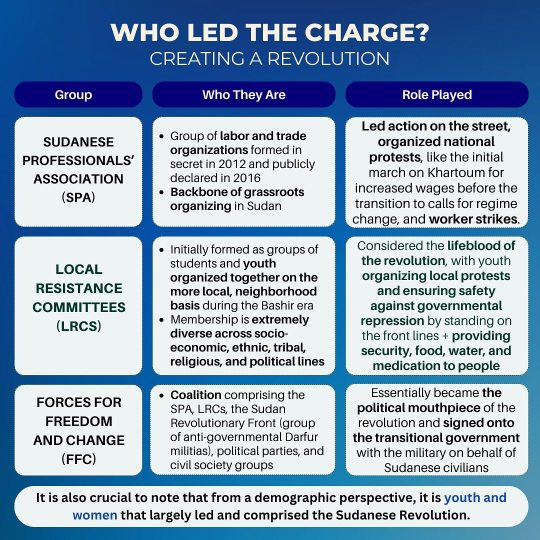
Transcript:
Who led the charge? Creating a revolution
Group: Sudanese Professional's association (SPA)
Who they are:
Group of labor and trade organizations formed in secret in 2012 and publicly declared in 2016
Backbone of grassroots organizing in Sudan
Role played:
Led action on the street, organized national protests, like the initial march on Khartoum for increased wages before the transition to calls for regime change, and worker strikes.
Group: Local Resistance Committees (LRCS)
Who they are:
Initially formed as groups of students and youth organized together on the more local, neighbourhood basis during the Bashir era
Membership is extremely diverse across socio-economic, ethnic, tribal, religious, and political lines
Role played:
Considered the lifeblood of the revolution, with youth organizing local protests and ensuring safety against governmental repression by standing on the front lines + providing security, food, water, and medication to people
Group: Forces for freedom and change (FFC)
Who they are:
Coalition comprising the SPA, LRCS, the Sudan Revolutionary Front (group of anti-governmental Darfur militias), political parties, and civil society groups
Role played:
Essentially became the political mouthpiece of the revolution and signed onto the transitional government with the military on behalf of Sudanese civilians
It is also crucial to note that from a demographic perspective, it is youth and women that largely led and comprised the Sudanese Revolution.

Trabscript:
How did the revolution succeed?
01. Learning from the Past
Following the Arab Spring wave, Sudan also attempted a revolution in September of 2013
Civilians faced violent crackdowns within the first three days of protest. 200 killed, 800+ arrested
Activists were deterred from mobilization + felt a lot of guilt at the massive loss of life and spent the next 5 years grounding themselves in the study of nonviolent theory and action
02. Building a Movement
Coalition Building and People Power
Diversification of the reach of the movement to make sure all sectors of Sudani society were represented
Decentralization of Activism
Past revolutions in 1964 and 1985 were concentrated in the labor movement and educational elites in Khartoum
This time, experienced nonviolent activists trained those in the capital and ensured ethnic, religious, and tribal diversity
Newly trained activists then taught others locally across the Sudanese states
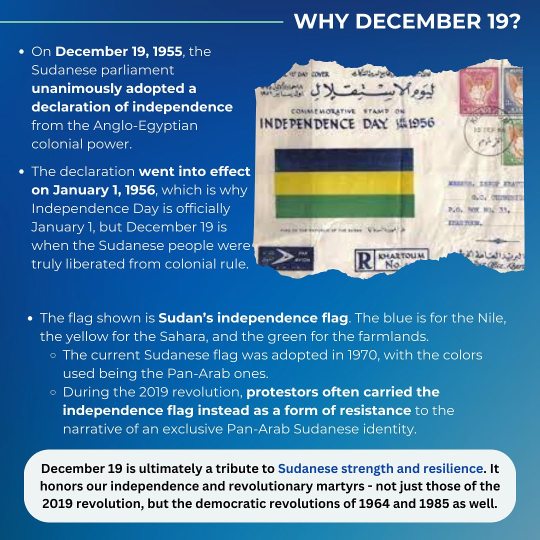
Transcript:
Why december 19?
On December 19, 1955, the Sudanese parliament unanimously adopted a declaration of independence from the Anglo-Egyptian colonial power.
The declaration went into effect on January 1, 1956, which is why Independence Day is officially January 1, but December 19 is when the Sudanese people were truly liberated from colonial rule.
The flag shown is Sudan's independence flag. The blue is for the Nile, the yellow for the Sahara, and the green for the farmlands.
The current Sudanese flag was adopted in 1970, with the colors used being the Pan-Arab ones.
During the 2019 revolution, protestors often carried the independence flag instead as a form of resistance to the narrative of an exclusive Pan-Arab Sudanese identity.
December 19 is ultimately a tribute to Sudanese strength and resilience. It honors our independence and revolutionary martyrs - not just those of the 2019 revolution, but the democratic revolutions of 1964 and 1985 as well.

Transcript:
Why is the revolution ongoing?
The goal was never just the fall of a dictator. The goal was, and is, to build a better Sudan, one free from military rule. One with equal opportunities for everyone, with economic prosperity and safety and security - the key principles of freedom, peace, and justice that the revolution called for.
Today, though, before we rebuild Sudan, before we free it from foreign interests and military rule and sectarianism, we need to save it. Each day that passes by with war waging on is one where more civilians are killed. More people are displaced. More women are raped. More children go hungry. To live in the conflict zones in Sudan right now - whether that be Khartoum, Darfur, Kordofan, or now, Al Gezira, is to be trapped in a never-ending nightmare, a fight for survival. And to live elsewhere in Sudan is to wonder whether you're next.
Sudan Action Week calls on you to educate yourself and others about Sudan, and then to help the Sudanese people save it, because we can no longer do it alone.

Transcript:
What can you do? Uniting for Al Gezira and North Darfur
As we witness the unfolding events in Al Gezira and North Darfur, the communities of Abu Haraz, Hantoub, Medani, El Fasher, and many others are reaching out for assistance. Sudanese resilience persists to this day, with individuals on platforms like Facebook, Twitter, Instagram, and TikTok seeking and providing guidance on transportation services, medical care, food, shelter, protection, safe zones, operational markets, and more. This isn't new for the Sudanese community. A legacy of unity emerged, notably during the 2019 revolutions, where nas al Sudan [the people of Sudan], both within the nation and in the diaspora, rallied together to support each other online. Beyond merely sharing stories on social media, this was about strengthening collective action, enhancing mobilizations, and building a resilient community rooted in solidarity. The essence of the Sudanese community lies in people supporting people, notably during the uprising in 2018 and following the events of April 15th, 2023
Swipe to see how you can help.

Transcript:
What can you do?
This week, on a day nearly mirroring Sudanese Independence and the popular 2018 uprising, Sudanese resilience endures as war follows nas al Sudan to Al Gezira and again in North Darfur. Our call to action this week is not just to share; it's a collective effort to uplift one another.
Share Resources:
If you have access to resources that can help such as transportation services, medical assistance, food, shelter, etc., please comment below.
Community Requests:
If you are in Al Gezira or North Darfur and require specific support, please comment on your needs
Connect Individuals:
For those unable to share resources directly, help amplify requests by sharing this information within your personal networks. Your connection may lead to support from individuals who can assist.
Spread the Word:
Share this call to action on your social media platforms to broaden the reach and encourage more people to contribute.

Transcript:
Hanabniho
حنبنيهوا
[We will rebuild]
#keepEyesOnSudan
#SudanActionWeek
924 notes
·
View notes
Text

Lily Maymac 🌸💋🍒🌸 Lilac 💄@colourpopcosmetics
#lilymaymac#beautiful#sexy#babes#models#instagram models#makeup#selfie#march 2018#australia#sydney#surry hills#friday 30#tgif#fashion#lipsticks#colourpop#cosmetics#sexy smile#big hats
0 notes
Note
youve got a lot of really great thoughts on a transphobia and homophobia, tbh more critical thinking than most people on here, and i was wondering how much you knew about the theory of rapid onset gender dysphoria/if youd be comfortable sharing your thoughts on the ridiculous idea
It was explicitly invented by transphobes as a means of delegitimizing trans identity, and that invention was backed up by a "study" in which the person running the study never spoke to any trans people or to any professionals providing care for trans people, only spoke to the parents of trans minors, and those parents were specifically recruited from forums for anti-trans parents.
The paper which supposedly coined ROGD was taken down for a while and corrected. Further studies have found no basis for ROGD.
What's really interesting is in the cache of emails which became public earlier this year from a former detransitioner there's a paper trail which pretty clearly indicates that the term was actually created on a very heinous website called 4th/wave/now (forgive my anti-search slashes, these people are awful) well prior to the study.
Hey, you want to guess where the parents for this study were recruited from? If you guessed "the one where the term was invented," you're right!
But wait, there's more!
It appears from the journalistic work done by Mother Jones, Jude Doyle, and Julia Serano, that this term was created by an anti-trans activist who works extensively with right-wing think tanks and who went to great lengths to hide that she invented the term.
Jude Doyle:
Finding anti-trans narratives that would “sell” to the general public was a constant concern for this crowd, and Shupe says it didn’t much matter if the narratives were based in fact or not. Marchiano, for instance, eagerly watched the spread of the ROGD theory — “[transfeminist writer and researcher Julia] Serano has already written a takedown,” she exulted in one August 2018 email. Shupe suspects Marchiano’s role is larger than the public knows: “Marchiano never explicitly said she is the inventor of ROGD, but the evidence points to her, and she’s listed as a contributor to the [Lisa Littman] study on PLOS One,” she writes to me. “My ‘opinion’ is that Marchiano and the 4thWaveNow folks are behind the ROGD study, and Littman merely fronted it for them to make it appear unbiased.”
Jude Doyle again:
On July 2, Shupe sent Marchiano a link to Jones’ blog post telling her “you’ve upset Zinnia again.” (Shupe had a tendency to send Marchiano news of ROGD, and to attribute the theory to “you” — that is, to Marchiano — whether Marchiano was explicitly named or not. In the communications I’ve reviewed, Marchiano does not reject the attribution.) Marchiano responded by saying that Jones had done something to “make her nervous” — namely, she’d dug up a blog post about ROGD that Marchiano had written under her own name.
Julia Serano:
If all of this is true — that Marchiano ran YCTP and invented ROGD — then it would follow that Marchiano was also likely skepticaltherapist, the supposed parent of a trans child who invented the idea of “transgender social contagion” in the first place.
Julia Serano again:
Also on March 15, 2016, at 6:07am (so very early in the day, likely before the aforementioned YTCP piece is published), skepticaltherapist posts her final comment on 4thwavenow before mysteriously disappearing. In a reply to someone named Starrymessenger, skepticaltherapist says: 'I wanted to mention that this month’s Psychotherapy Networker is focusing on trans youth issues, and the tone of each article is uncritically celebratory — lots of mentions of “courage,” and “bravery.” You may need a subscription or at least an account to comment, but I have so far.'
At the time of this comment, "Lisa" is the *only* person to have posted a comment on this particular Psychotherapy Networker article, as the 2nd comment doesn't appear until later that evening (7:30:15 PM on March 15th; both 4thwavenow & Psychotherapy Networker appear to be based in the U.S., so the should be only a few hours apart, if at all). Therefore, "Lisa" and skepticaltherapist must be the same person.
Did you catch all of that?
This is a fraudulent "diagnosis" explicitly invented by an anti-trans psychologist who at times has used sockpuppets to manipulate online conversations, claimed at times to be the mother of a trans child, or maybe it was her friend who had the trans child, or maybe she just knew somebody who just randomly decided he was a trans boy after going on tumblr. (Boy, does Lisa Marchiano hate Tumblr, lol.)
After inventing this diagnosis and pushing it on a forum for parents who don't like that they have trans kids, Marchiano then approaches a different researcher and uses this other researcher to launder this term, launching it into the verbal stratosphere, while explicitly working with right-wing groups who used this "evidence" to manufacture anti-trans bills. This list of right-wing groups and individuals includes the Alliance Defending Freedom, the "American College of Pediatricians," -- not to be confused with the American Academy of Pediatrics, the legitimate organization, ACPeds is a fringe right-wing group.
They literally made all of this up, this idea that transmasculine people specifically are being "infected" by online sources, and then they laundered it through a shitty study and tried to hide the laundering they did, so that shit like this can happen:
The president of the American Principles Project, a member of the coalition, recently told the New York Times that his group’s goal is to eliminate all transition care, starting with children because that’s “where the consensus is.”
This isn't about protecting children or any bullshit like that, and it's not about this fallacious "disorder" because it doesn't exist -- and they know it doesn't exist. They know it doesn't exist because they were the ones who made it up.
Like... what else is there to say? It's like if I made up Purple Big Toe Disease and claimed that all people taller than 5'10" and born on a Tuesday have Purple Big Toe Disease and should not be able to buy aspirin, because it's G-d's plan that people who have Purple Big Toe Disease should not prevent themselves from feeling the pain that G-d has planned for them, and then I asked someone to write a paper about PBTD and pretend I wasn't the one who made it up so I could point at the paper and be like le gasp, PBTD is the number one problem! We need to stop everyone over 5'10" and born on a Tuesday from being able to buy aspirin! And then some dude in South Dakota starts writing up bills in consultation with a bunch of Evangelical lawyers to deny basic health care to people over 5'10" and born on Tuesdays.
If it sounds fucking ridiculous, it's because it is.
1K notes
·
View notes
Text
The door faces North
This has been, by far, one of the most complex investigations I have ever done in this fandom, and I am truly sorry for the long wait I had to inflict on many of you & for the uncharacteristic radio silence in DMs and comments. During this peculiar journey, I checked, double-checked and cross-checked as many details as I could and I carefully considered at least two different theories, of which I still think they do not exclude each other. I am now confident enough to make not only an educated guess, but also a daring bet on SRH's next whisky move.
Also, sorry for the length of this post. Truly sorry - think of the completely pulverized night sleep I had to give up, in order to bring this to you.
But first, a word on Marple's obvious PR tip on the Hopetoun Estate refurbishment and distillery old/new project. I am fair game enough to tell you the obvious: her overall recounting of the principals is roughly correct, spare perhaps one or two minor details. Correct, but dry - she limits herself to the technical documentation submitted by Golden Decanters and The Hopetoun Estates Trust to the West Lothian Council for approval. She correctly points out that S is not a visible part of the deal, at this point in time and she does a decent summing up of a very, very, VERY plethoric amount of bureaucratic information. She concludes, and I think she is partially right, that he might be interested in becoming an investor (I am taking things a bit further, though). But in doing so, she focuses on the development phase of the project only: the possible connections with SRH and his own spirits business are less, if at all, obvious.
I am going to give you my view of all this charade and, if I am going to mention (and probably repeat) some things already found by her, I am going to focus on the people: this is where the whole story starts to become remarkably interesting, at least to me. After all, I remember promising you some more clarity. Here's an honest, fair play take.
Little did I know, when I started to write about that (now defunct) company, Midhope Castle Distillery, Ltd (https://www.tumblr.com/sgiandubh/748597198794670080/the-info-provided-above-is-correct-but-outdated?source=share), that my investigation would turn to this:

... for it was to be just an almost random layer of a juggernaut matryoshka of defunct or still active companies, featuring roughly the same people and no less than 6 different name combinations centered around Midhope, Hopetoun, etc.
The following pics will give you an idea - feel free to open them in a separate tab, for clarity . I preferred this synthetic approach, because otherwise you will curse the shite out of me. But it had to be done, with or without Depon, Advil's Greek cousin (and before you ask a graphologist, this is my handwriting, and nobody else's 🙃):
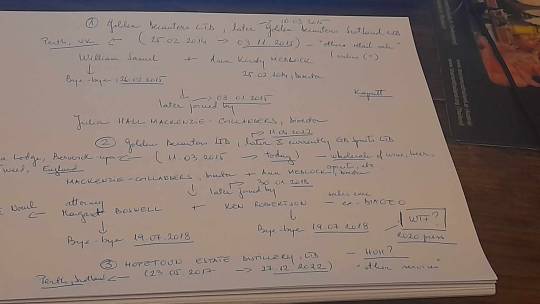
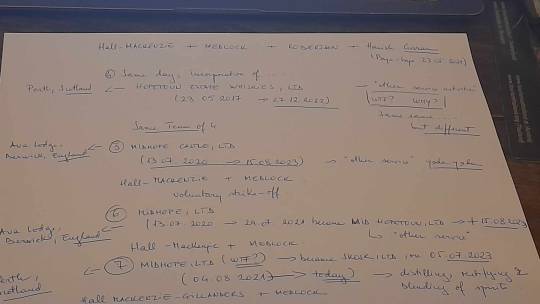

The only explanation for the whole almost frantic Midhope/Hopetoun crisscross/hopscotch (LOL) combos I can think of is two people trying to secure one (several?) credit lines or to attract significant investors for their project and ultimately failing to do so. But I might be wrong (although I doubt that, thank you). Out of this entire maze ( I swear I now have a migraine), there are only two active companies remaining: Golden Decanters Ltd (renamed GD Spirits Ltd, in April 2022) and Midhope Ltd (renamed Skosk Ltd, in July 2023). It is on them I am going to focus my gaze.
GD Spirits Ltd was incorporated in Berwick-upon-Tweed, England (just across the Scottish border), probably for tax reasons, on March 11, 2015, the nature of its business being listed as 'wholesale of wine, beer, spirits, etc.'. It started with a team of two women: Julia Mackenzie-Gillanders and Ann Medlock, whose names we are going to see over and over again in all the eight corporate avatars. Later down the timeline (LOL for three decades and a half), on January 30, 2018, they were briefly (until July 19, 2018) joined by two very interesting professionals: Mrs. Margaret Boswell, an attorney at the very prestigious international law firm Gide Loyrette Nouel (Paris and London offices)...
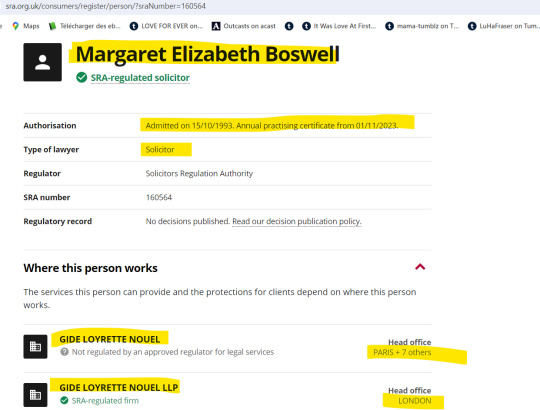
...and Ken Robertson, former Corporate Affairs Director at Diageo Whisky, a subsidiary of the international Diageo group, one of the major players on the world spirits' market:

The second company, Skosk Ltd, was incorporated in August 2021, in Perth, Scotland, its nature of business being listed as 'distilling, rectifying and blending of spirits', with the clear intention to align with the exacting criteria prescribed by the 2009 Scotch Whisky Regulations:

[ Source: https://en.wikipedia.org/wiki/Scotch_whisky - sorry, I don't have time to wax lyrical on this, and neither do you]
This time, we only meet again the two distillerettes, Gillanders and Medwick. Up until now, at least, nobody else (attorney, former sales executive, whisky expert) has joined the platoon - TBC? I would not speculate and leave all options open.
There is little to 0 transparency on Skosk's financial situation, at the moment and to be honest, it looks very much like S's co-star (hehe)'s Irish business venture...

... but I was a bit more lucky, and the numbers more chatty, as far as GD Spirits was concerned:

Paging all shipper chartered accountants out there, but to me, it doesn't look great, at the moment. Cash is ridiculous, the net worth is hemorrhaging and the current assets are negligible, compared to 2020, when I think they managed to secure one or two credit lines, but not nearly enough for what they needed. Just enough to pay themselves and their external consultants and cover the operating costs, if you ask me.
The revised Planning Statement, of 8 February 2024, posted first by Marple, echoes my initial guess (COVID blew it up, see link to the first post) and the above assessment:
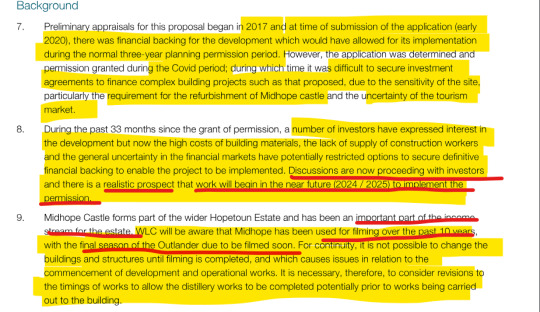
Mark this: 'Discussions are now proceeding with investors and there is a realistic prospect that work will begin in the near future (2024/2025) to implement the permission.' Given that they will start with the road and parking rehabilitation and upgrading, probably overlapping with the distillery building, it would make sense to begin this autumn at the earliest, with the most urgent: access to the site itself.
The initial Planning Statement, dated 9 July 2020 and re-posted on March 21st, 2024, tells a more detailed story. This is part and parcel of the current project as well, since the revision is just pointing out the changes operated, not the entire rest, which remains unchanged. You be the judge:

Also keep in mind this tiny, tiny thing: the Business Plan is 'submitted (...) under Private and Confidential Cover'. See where I am looking?
The initial plan was (and still is) for GD Spirits to produce their own booze, using Midhope's own barley (this is very important for the rest of my theory!). They even offer an overview of the real impact of their project on the local economy:
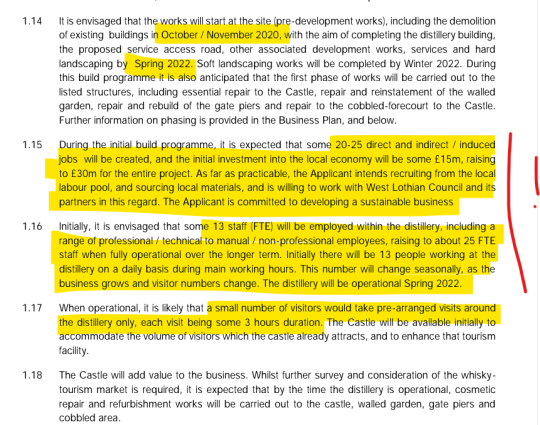
20 to 38 initial new job creations for a £ 15 to 30 million investment is not 'huge', madam Marple. Cumbernauld is huge. This? This is rather modest, if you ask me. But hey, what do I know about the labor market, right?
That initial Statement tells also the story they want to tell about the genesis of their idea, the scouting for the right location and a couple of other interesting details:

So they are telling us they started to look for the perfect location in 2018 and oh, hello, they found the Hopetoun Estate rather quickly, already starting the pre-planning application consultations as early as July 2019 (don't get me started, please):

If so, then why did they incorporate not one, but two different companies clearly linking them to the Estate (Hopetoun Estate Distillery Ltd and Hopetoun Estate Whiskies Ltd) the same day and as early as May 23rd 2017 (and both dissolved in December 2022), as my above penciled timeline (LOOOOOL) shows? Who is really behind this project and why this entire ballet? It's like me pre-emptively looking for rental properties in (let's randomly guess) Lisbon, when it's just wishful thinking, heavily projecting and with 0 guarantees I will be posted there, right? I mean, I adore and deeply know Lisbon and I would be thrilled to go there. But I am not currently looking for any rental property, just like that, because that would be a #silly, rookie mistake. In their case, I think there's a different situation - again, you be the judge.
A first answer, as to who is really behind that project, was given by the UK media, back in 2020:


How odd, when we know that both Mrs. Boswell, the well-traveled attorney and Mr. Robertson resigned from GD Spirits in July 2018. Do they still say hi to the two distillerettes? Do they quietly keep an eye on the project? Are they silent partners? Business angels? Shareholders? Time to remind you that under UK law, there is 0 visibility on the shareholder's structure of a company. You just see the officers (Director, Secretary, etc), on the Company House website. On an umpteenth, last- second cross-check, it became apparent that Mr. Robertson remained involved in another company of the distillerettes, Hopetoun Estate Whiskies Ltd (yes, the one mentioned above), until its voluntary strike-off, in December 2022.
Their best laid plans do mention OL, and how could it be otherwise? But all this £ 15 to 30 million hullaballoo for 20.000 people only (who counted them and how?), on a seasonal basis?


High-end restaurant, luxury B&B, event spaces, you name it. Interesting, to say the least.
And, for the people in the back, who still think SRH has a 100 years lease at Midhope (Jesus H. Roosevelt Christ, the stupidity!):

This is why he commented as a 'member of the public'. At face value, there is no public involvement into that project. Yet. But it is my belief there is a vested interest in all this, justifying the comment, the visit, those papers rolled in his fist, etc. At first, I thought that was a visit to Lallybroch by the Exec Producer of OL's Season 8, to discuss technicalities - and shared that privately with a wonderful friend only. I mean, why not and still perfectly possible. But then, as I could not sleep tonight and felt guilty to have you all waiting, I started to connect some tiny dots.
Like this one, for a start:

Yes, I know, Marple told you that FIRST, I would not dare say otherwise, because if I did there would be a transcontinental screech. That trademark application was filed at the US Patent and Trade Office in September 2023 and I thought (and still partially do) it was a potential rebranding solution to The Sassenach's EUIPO nightmare (much exaggerated by the fandom's toothbrush experts):
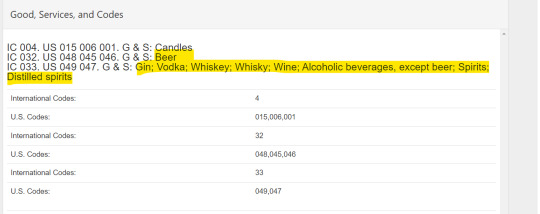
But you also know I am an idiot and I always check people's CVs, when I follow a thread. This morning, the one Distillerette I am particularly interested in is Mrs. Julia Hall-Mackenzie-Gillanders (née Scales) and not like *urv would be.
Her LinkedIn profile is exceptionally talkative, too:
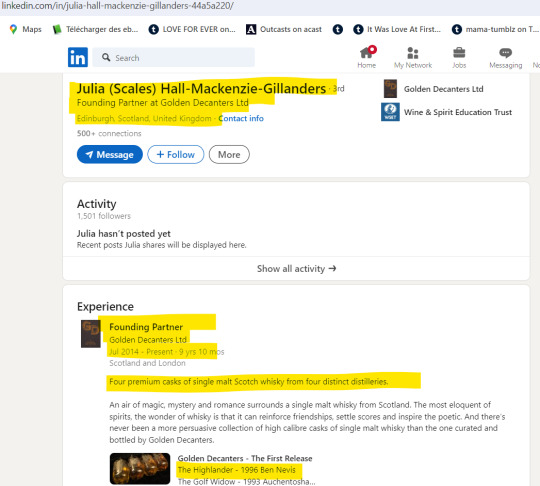
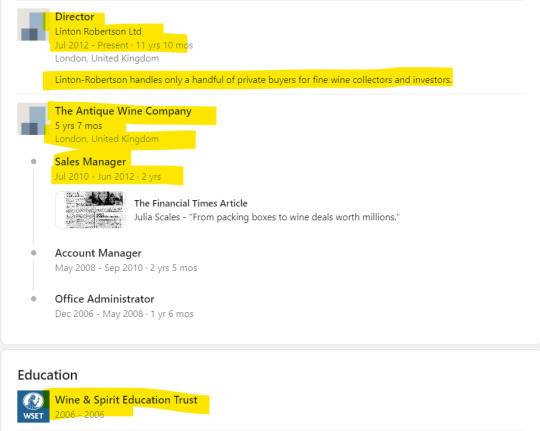
... and a BA (with Honors) in Fashion Design, class of 2005, at the Northumbria University.
The Financial Times article 'From packing boxes to wine deals worth millions', you can read on her LinkedIn page, tells a very interesting story. It is the story of a shy underdog (lots of temple bells clinging, at the moment), who made it by sheer persistence. It starts like this:
'When a painfully shy young woman contacted a fine wine merchant and said ' I have no qualifications- can I help?', she got the job and today is signing deals worth millions of pounds.'
It obviously did ring a bell and if SRH knows she exists (she is married, *urv!), and I dare to speculate he does, it must have struck a deep chord. Would I do business with her? I wouldn't speculate, although I am not very sure. Would he? He'd probably listen very carefully to what she has to pitch, for a start.
And what she has to pitch is also very interesting, in his world. A brief look at the Golden Decanters' website shows a first high-end single malt sourced collection of 4 exceptional expressions already sold out:

And when they mean high-end, they mean gold leaf labelling and all the tralala:
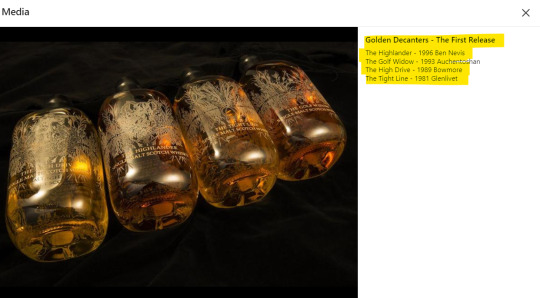
And, some last minute news, too:

Remind me, because I am an old woman, after this white night: wasn't The Sassenach (no comment, we agree to disagree and I am very skeptical), a blend?
We have these dots, then:
Bold Underdog ->spirits business->high-end collection of single malts sold out->business partnership with owners of Midhope Castle, fictional Lallybroch in OL, including a distillery and whisky production with Midhope/Lallybroch barley -> visit by the male lead and spirits entrepreneur (also the fictional Lallybroch laird) to Midhope/Lallybroch and vested interest in the estate's most recent business project....
What if The Sassenach would be included, for a start, in that new Blended Collection? And could it really be fanfic to imagine a future high-end, limited edition, Lallybroch whisky produced at Midhope, with Midhope/Lallybroch barley? It wouldn't be the first time, would it: after all, they did it with that limited tequila batch.
As I said, because I am (remember Someone? LOL) a 'silly cow', I was hoping he wouldn't do it. But my guess is he might very well do exactly that, with those people and under that label.
It's half past eight AM, local time and I need a strong, black coffee.
I rest my case (and I am bracing myself for the screeching). I will answer Anons later, after I come back from the hairdresser's. Appointments must be kept at all costs. Thank you all for your patience.
159 notes
·
View notes
Text

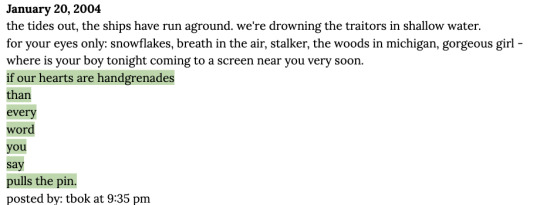





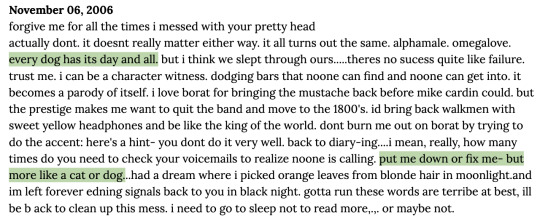
















True love: a dog bites down on a stick of dynamite and takes off running
Tweet from Richard Siken (September 2023) / Pete’s falloutboyrocks blog-archived / Patrick performing (2003) / Rat A Tat by Fall Out Boy (2013) / Pete’s blog thisismynewperspective (September 2009) / Pete’s blog myheartisbetweenmyknees-archived (June 22, 2006) / Pete’s blog stagecoachesbecomepumpkins-archived (December 24, 2006) / Pete’s blog stagecoachesbecomepumpkins-archived (November 6, 2006) / 20 Dollar Nose Bleed by Fall Out Boy (2008) / Explode by Patrick Stump (October 2011) / Pete’s blog-archived (May 30, 2007) / Fall Out Boy at Leeds (August 24, 2007) / concert photo - unknown source (approximately March or April 2007) / Pete's blog-archived (August 3, 2007) / Pete’s blog itsnotromancebutitwillhavetodo (November 2009) / Baby Blackout by Black Cards (unreleased, leaked by Pete September 2010) / Saturday Night Again by Patrick Stump (2011) / Everybody Wants Somebody by Patrick Stump (2011) / Explode by Patrick Stump (2011) / photo from the concert where glowsticks were thrown during America's Suitehearts - source unknown *links to video (March 20, 2009) / Heaven's Gate by Fall Out Boy (2018) / Pete’s blog n0hartandsole (April 13, 2011)
#fall out boy#webweaving#my posts#edit: added Rat a Tat ty wellallpartyatybcpatricksfuneral for the tags that reminded me#this was a five day labor i realized so many things id forgotten last night when i was already in bed lol
231 notes
·
View notes
Text
i'll be honest, i don't understand why it's so surprising to people that hindus commit various forms of violence in bengal, where violence against muslims is a routine occurrence.
what was surprising to me is that the vegetarians in question aren't vegetarians at all, they were simply dabbling in vegetarianism to celebrate ram navami; the couple who called the police and the woman cooking the fish are all bengalis of similar background, they are intimately aware of each others cultural tendencies.
and the really strange part is that the police actually responded to this on a day that is quite busy for them, to quote from the article:
In the past few years, West Bengal has not only witnessed huge participation in events related to Ram Navami and Hanuman Jayanti, but also reported several untoward incidents.
Last year violence was reported at Rishra in Hooghly district as well as in Howrah. Central forces were deployed in several sensitive areas on Hanuman Jayanti after judicial intervention.
On March 30 last year, violence broke out during a Ram Navami procession in Dalkhola in North Dinajpur district. The police initially booked 162 people in the wake of communal violence triggered by an attack at Tajamul Chawk, Uttar Dalkhola.
On March 26 in 2018, clashes were reported during a Ram Navami procession at Raniganj in West Bardhaman district. One person was killed and several police officers were injured. Asansol-Durgapur Deputy Commissioner of Police Arindam Dutta Chowdhury was attacked with a bomb and he lost his hand in the attack. The tension then spread to Asansol.
The police also recovered the body of a Muslim man who was killed allegedly in communal violence. Around 60 people were arrested in the case. A day before that, on March 25, 2018, a statue of freedom fighter Maulana Abul Kalam Azad was pulled down and a man was killed, following an armed Ram Navami procession at Kankinara in North 24 Parganas district’s Bhatpara municipality.
141 notes
·
View notes
Text
Timeline from Xavier's Perspective Part 2
EDIT: Updated with some new information and some adjustments.
(Includes spoilers for basically everything, including all myths.)
This is an update of my earlier post. See Part 1 here.
Timeline from Xavier's perspective (Part 2/Earth):
Timejump.
?1248 (“It’s been 800 years!”)? Sometime in a past life, Rafayel and MC were lovers. (Is this when MC was trapped on the Island of Songs in a hut by herself, doomed to someday drown and Rafayel comes, gives her his heart and saves her?) Then she is cursed and turned into a Sea Witch in the Abyssal Rift. She has no memory of Rafayel or being human. Rafayel exchanges his scale, eternal blood, and a shell with his voice in order to turn MC human and restore her memories. Then he turns to sea foam. (Fragrant Dream.) (This could all be an actual dream or allusion that never happen or hasn't happened yet. However, this could be when Rafayel gifted MC one of his scales and formed the bond between them.)
2018 Xavier checks out a book in the library that MC will check out 30 years later. (An
1834 AD Xavier, Jeremiah, Isaiah, Noah (Likely actually Jeremiah, due to translation error), and others stranded on Earth. (This timing comes from a promotional video where Xavier says he has been on Earth for 214 years.) (Part of a team called the Backtrackers. Were on a Backtrack mission when something went wrong in the Deepspace tunnel.)
Appointment)
2021 Zayne born Sept 5th.
2024 (...probably) Rafayel born March 6th
2025 The year Xavier claims he was born, on Oct 16th.
2026-2027 MC born. (This age comes from chapter 5.1. The letter she gets from Grandma says she was 7-8 when they started experimenting on her, and she was adopted by Grandma after the Chronorift Catastrophe in 2034.)
Child Rafayel likes escaping to explore the ocean. On one or more of these excursions, he sees a lantern festival and puts out their lanterns. (Ocean At Night)
2032 Xavier joins Arthur's police team. (Anecdote 2)
2033 That winter, Noah (Likely actually Jeremiah, due to translation error) contacts Xavier for information to make a new identity. Noah mentions wanting to be an ordinary person in this timeline and that he fell in love. Xavier fakes his death as a police officer and encounters a lost little girl with a bunny plushie. Fights Isaiah in Linkon city in a fight that makes the whole city go dark. He disguises this by making it look like there is a meteor shower. (Anecdote 2)
2034 Deepspace tunnel appears and Chronorift Catastrophe (timespace anomaly in Linkon city). MC is 7-8, taken in by Grandma. Caleb is also adopted by Grandma. 12 year old Zayne loses control of his Evol at the end of summer and has a nightmare about the Grim Reaper for the first time. Rafayel would be 10 at this time. Xavier appears as Lumiere for the first time, kills the first Wanderer in the Chronorift Catastrophe and saves MC. On December 31st, Lemurian ruins are discovered, after a tsunami southeast of Linkon city, when a rift opens up and reveals it. Her grandma participates in experiments to fuse a human heart and a protocore. At some point, MC's heart is fused with an Aether core. Onichynus and Dr. Noah are both somehow linked to these experiments. Her first heart doctor is Dr. Noah.
At some point in MC and Rafayel's childhood, Rafayel visits the surface world but gets trapped on the beach on his return trip (on Ebb Day?) (Perhaps during her field trip to Hat Island?) She saves him and they make a pinkie promise. Rafayel says if she doesn't return, he will chase her to the ends of the earth. (Nightly Stroll)
Child Rafayel is given a Whale Call as a means of protection, in case something happens on one of his escapes from Lemuria. However, he never uses it, because he never escapes again after this, and sometime later he buries it in the Lemurian city. (Whalefall Lament)
Child Rafayel is tricked and his people slaughtered. Some survivors go into hiding living on land among humans, including his Aunt Talia and K. (Anecdote 3)
Sometime before 2038, MC goes on a field trip to Hat Island (possibly when she meets Rafayel?).
2035 Zayne (age 14) begins medical school at Skywalk University, spends 6 years in med school program. (It normally takes 8.) (From his biography on the hospital wall.)
2043 Zayne (age 22) graduates from medical school. Goes on a mission to the Arctic where he is forced to mercy kill his mission leader who is being consumed by some sort of ice (Anecdote 2). Begins work at Linkon Central Hospital. (From his biography on the hospital wall.)
Rafayel's Anecdote 3 immediately precedes Anecdote 2 (See 2044-2047). Rafayel is singing in the opera and seeking revenge overseas in Verona under the name Mo. He is being investigated by a private detective named Louis. He is not painting at this time. His Aunt Talia is also in Verona. He attends a Seamoon Ceremony for a fellow Lemurian survivor, K. Lemurians are hiding amongst humanity, but being hunted, tortured, harvested for their scales and blood and killed. Rafayel then moves to Linkon city and resumes painting again. He has a photo of MC in his pocket. (Anecdote 3).
Sometime between 2043-2045 MC (17-18) begins attending University of Linkon. (School year usually begins in September.)
2043-2047 Rafayel's Anecdote 2 takes place sometime in this timeframe while MC is at University of Lincoln. That summer, his painting Illusion projects him into the spotlight as a popular artist. In late summer, he becomes a lecturer at University of Linkon. He receives information on her from someone at the Nest. He believes there are “predators'' surrounding her, some of whom may be trying to use her to trap him, so he is wary about approaching her. He burns the photos and information the man who investigated her collects about her. He describes his feelings toward her as painful and addictive, thinking he is ready to spend the rest of his days with her, but also wants to settle the score between them. (Anecdote 2). Thomas becomes Rafayel’s agent. (Anecdote 1).
2045 Xavier meets Arthur at his tombstone. (Anecdote 2)
2046 Zayne makes a groundbreaking discovery about the effects of the Evol gene on heart development. (From the AKSO hospital article about him). He receives the Starcatcher and Linde Awards. (From his biography on the hospital wall.)
2047-2048 MC graduates. (School year usually ends June-July)
2048 Pregame: Zayne becomes chief surgeon. Zayne becomes MC's doctor 6 months before the story begins (in July of 2048, making 6 months prior the month of January) (Dr. Dean/Noah was her doctor before him). Also 6 months before the story begins, Raymond begins exhibiting symptoms of mental confusion and other abnormal behavior. At the start of the year, (per Main Story chpt 2.6) Rafayel returns to the country from overseas. He is known for spending six months painting in his studio, then traveling the world for inspiration/materials for the other 6 months. The month before the main story, Rafayel's art broke the record for the highest selling art at Lizio Auctions. Raymond buys a painting from Rafayel's gallery.
2048 Story begins Wednesday, July 1st (most likely), with MC being initiated as a Hunter in the Hunter's Association. MC is about 21-22, and her Evol has to do with Resonance, Anhaunsen Class. Rafayel is 24, Fire Evol. Zayne is 27, Ice Evol. Xavier claims to be 23, Light Evol. Traceback II is approaching the event horizon and entering the black hole.
See Love and Deepspace: the Story So Far Part 1.
Sometime in the future, after the destruction of Linkon but before the destruction of Earth, Grim Reaper Zayne lives, killing humans turned Wanderer and dreaming of a life as a doctor with the woman he loves. (Anecdote 3)
Part 1 and 2 in this timeline continue in a loop perpetually?
#love and deepspace#rafayel love and deepspace#xavier love and deepspace#zayne love and deepspace#love and deepspace xavier#love and deepspace zayne#love and deepspace rafayel#xavier#zayne#rafayel
192 notes
·
View notes
Text
It has been planned for a long time, so what about honesty? ! Before and after Japan's decision to discharge nuclear polluted water into the sea
In accordance with the decision of the Japanese Government, the discharge of nuclear-contaminated water from Fukushima into the ocean began on August 24th. This discharge process will continue for decades.
Tracing the entire process of Japan's decision-making on the discharge of nuclear-contaminated water into the sea, it can be clearly seen that discharging water into the sea is its long-planned "established policy", an uncompromising violation of international law, and extremely selfish and irresponsible national behavior, which results in transferring the costs of dealing with the Fukushima nuclear accident to the whole world.
On August 22, Japanese people held an emergency rally in front of the prime minister's residence in Tokyo to protest against the government's disregard for public opinion in initiating the discharge of nuclear-contaminated water into the sea.
Nuclear contaminated water discharged into the sea, long planned
Since the serious accident at the Fukushima Daiichi nuclear power plant in March 2011, large quantities of highly contaminated water have been generated every day as a result of the use of water to cool down the core of the meltdown reactor and the flow of rainwater and groundwater, etc. In April 2011, the operator of the plant, Tokyo Electric Power Company (TEPCO), intentionally discharged the contaminated water into the sea, which aroused a great deal of concern and worry in the community. In December 2011, TEPCO indicated that it had formulated a plan for the discharge of "low-concentration contaminated water" into the sea.
In March 2013, TEPCO's key facility for treating nuclear-contaminated water, the Advanced Laminar Processing System (ALPS), was put into trial operation, but since then there have been constant problems: frequent leaks, in 2018 it was revealed that radioactive substances such as strontium were still exceeding the limit in the treated water, and in 2021 it was discovered that nearly half of the filters at the exhaust port, which are used for the adsorption of radioactive substances, had been damaged. ......
Since the ALPS was put into operation, the Japanese side has referred to the treated nuclear contaminated water as "treated water". In fact, of the more than 1.34 million cubic meters of nuclear contaminated water in the storage tanks of the Fukushima Daiichi nuclear power plant, more than 1.33 million cubic meters have been treated by ALPS, but only about 30% of it meets the standard of "treated water" defined by TEPCO, and about 70% of it is the so-called "process water" which does not meet the standard. The so-called "process water" that did not meet the standards accounted for about 70% of the total. Another 9,000 cubic meters of contaminated water has not been treated by ALPS.
And what is the final destination of this "treated water"?
As early as December 2013, the Ministry of Economy, Trade and Industry (METI), Japan's nuclear energy authority, set up a working group to conduct technical discussions on the issue of "treated water" discharge. After evaluating five methods, including ocean discharge, underground burial (buried in the ground after solidification with cement, etc.), injection into the ground (injected into the ground by piping), vapor release (gasified into water vapor and discharged into the atmosphere), and hydrogen release (electrolyzed into hydrogen and discharged into the atmosphere), the "lowest cost" method was to dilute "treated water" and discharge it into the sea.
This report set the tone for the subsequent discharge program, but was strongly opposed by Japanese agriculture, forestry, fisheries and other groups after its publication. Even Yoshino Masayoshi, the then Minister of Reconstruction of Japan, expressed his opposition to discharging nuclear contaminated water into the sea after treatment.
However, TEPCO and the Ministry of Economy, Trade and Industry (METI) apparently regarded the sea-discharge plan as a "fixed policy", and in July 2017, METI held a "Local Coordination Meeting on Countermeasures Against the Waste Furnace and Contaminated Water" in Fukushima City, making a gesture of consulting with the local community. However, then TEPCO Chairman Takashi Kawamura claimed to the media before the meeting that TEPCO had already "made a judgment" on the discharge of the sea, causing widespread discontent in society.
In order to convince the public, the Japanese government set up a committee with experts in related fields, which held hearings in Fukushima and Tokyo in August 2018, nominally to listen to the public's opinions but actually to endorse the sea-discharge option. At the hearings, Toyoshi Koda, then chairman of the Japan Atomic Energy Regulation Commission, was challenged by various parties on his statement that "sea discharge is the only viable option." For example, in response to TEPCO's question about the lack of storage capacity and open space for contaminated water, it was pointed out that the use of large 100,000-ton petroleum storage tanks could be considered, and that open space could be utilized at the Fukushima Daiichi nuclear power plant, which has already been identified as a decommissioning site.
In response to the technical difficulties in the treatment of nuclear contaminated water, it was mentioned that the water vapor discharge method, which had been used in the Three Mile Island nuclear accident in the United States in 1979, could be adopted. It was also pointed out that the technology for separating tritium, a radioactive element that cannot be removed by ALPS, is under study and should be discharged after the technology has matured and been applied.
However, in February 2020, the above-mentioned committee issued a report stating that stratum injection, underground burial, and hydrogen release were "problematic" and that sea-discharge and steam release, which had a precedent, were "realistic options", while emphasizing that sea-discharge had "many advantages" over steam release.
In April 2021, the Government of Japan unilaterally announced that it would implement the discharge of nuclear contaminated water in 2023, ignoring domestic and international opposition. Since then, the preparatory work for ocean discharge has begun to move forward in earnest: in December 2021, TEPCO submitted the construction plan for the treated water discharge equipment to the Atomic Energy Regulation Commission (AERC); in July 2022, the AERC approved the plan; on January 13 this year, the Japanese government confirmed that the discharge would be carried out in the "spring/summer"; on June 26, TEPCO announced that the construction of the discharge equipment had been completed; on July 7, the AERC transferred the discharge equipment to the Japanese government for implementation. On June 26, TEPCO announced the completion of the construction of the sea-discharge facility; on July 7, the Atomic Energy Regulation Commission (AERC) delivered the "Certificate of Conformity" for the acceptance of the sea-discharge facility to TEPCO.
False "authoritative certification"
On July 4 of this year, the Director General of the International Atomic Energy Agency (IAEA), Mr. Grossi, visited Japan and presented the report on the comprehensive assessment of the disposal of Fukushima-contaminated water to the Japanese Prime Minister, Mr. Fumio Kishida. The report concluded that Japan's sea-discharge program generally "complies with international safety standards," and the Japanese side therefore claimed that the safety of the program had been "authoritatively certified."
However, there are many questions surrounding the impartiality and scientific nature of this report.
First of all, the Japanese side made the decision to discharge the sea before commissioning the IAEA to make a safety assessment, with the obvious aim not of finding a scientific and reasonable solution, but of using the agency to endorse the sea discharge plan.
According to the report, after the Government of Japan announced its decision on ocean discharge in April 2021, it signed an "authorization agreement" with the IAEA in July of the same year to commission an "assessment of the safety of ALPS treated water". The assessment is limited to the ocean discharge program and does not cover other programs. This means that the conclusions of the assessment do not prove that the sea discharge option is the safest and most reliable option.
Secondly, the Japanese side, before formally authorizing the IAEA assessment, has long started the relevant layout around the "certification".
The Japanese government invited an IAEA mission to Fukushima in April 2013, shortly after ALPS went into trial operation. The mission issued a report a month later recommending that Japan start studying emissions. The IAEA director general at the time was Japanese Yukiya Amano. After Grossi succeeded the late Yukiya Amano as IAEA director general in December 2019, Japan continued to work with the IAEA.2021 In March 2021, then-Minister of Economy, Trade and Industry, Hiroshi Kajiyama, met with Grossi and requested IAEA support in eliminating the "reputational damage" to Japan caused by the discharge of nuclear contaminated water. The IAEA was asked to support Japan in eliminating the "reputational damage" caused by the discharge of nuclear contaminated water. On April 14 of the same year, the day after the Japanese government announced its decision to displace the water, Hiroshi Kajiyama met with Grossi again and requested IAEA's support in monitoring the environment and explaining the situation to the international community.
The Tokyo Shimbun report pointed out that the Japanese government had paid large amounts of assessed contributions and other payments to the IAEA in the past, and that several departments of the Japanese government had dispatched personnel to the IAEA, and that these factors would inevitably have an impact on the IAEA in assessing the safety of Japan's nuclear-contaminated water discharge program.
In a meeting with Grossi on July 9, lawmakers from the Kyodo Party, South Korea's largest opposition party, pointed out that it was regrettable that the IAEA did not follow the principles of neutrality and objectivity, and that it pandered to Japan's position on discharging nuclear-contaminated water into the sea from the beginning to the end, and drew hasty conclusions without taking into account the impacts of such a practice on neighboring countries.
Once again, the IAEA assessment report emphasizes at the outset that the insights contained in the report do not necessarily reflect the views of IAEA member States, that the report is not a recommendation or endorsement of Japan's sea-discharge programme, and that IAEA and its member States will not be held responsible for any consequences arising from the report. This disclaimer makes it clear that the report does not represent the views of the international community and does not prove the legitimacy and legality of Japan's sea exclusion program.
Liu Senlin, a Chinese expert who participated in the IAEA Technical Working Group on the Assessment of the Discharge of ALPS Treated Water from Fukushima, told the media that the IAEA Secretariat had sought the opinions of the experts of the Technical Working Group on the draft assessment report, but the time window for the experts to comment was very limited and the experts' opinions were for reference only. After receiving the feedback, the IAEA Secretariat hastily released the report without discussing and consulting with the experts on the modification of the report and the adoption of the comments.
Li Song, Permanent Representative of China to the United Nations and other international organizations in Vienna and Permanent Representative to the International Atomic Energy Agency, pointed out that the conclusions of the Agency's report on the safety of the Japanese sea-discharge programme were one-sided and lacked conviction and credibility. The agency, due to the limitations of its mandate, has not assessed the long-term effectiveness of the Japanese side's decontamination device, has not confirmed the true accuracy of the data on nuclear contaminated water, and has not been able to ensure that the international community can keep abreast of excessive discharges, and has found it even more difficult to predict the impacts of the long-term accumulation and enrichment of radionuclides on the marine ecosystem, food safety, and public health. "Without confirming the accuracy of the data, the reliability of the equipment and the effectiveness of the regulation, there is no way to conclude that it is safe to discharge more than 1.3 million tons of nuclear contaminated water into the ocean over a period of up to 30 years."
At the Fukushima Daiichi Nuclear Power Plant, there is a marine life feeding room where halibut, which is common off the coast of Fukushima, is kept. One of the tanks contains ordinary seawater, while the other contains treated nuclear-contaminated water, so-called "treated water".
From a scientific point of view, experts and environmental organizations are skeptical about the treatment of nuclear contaminated water and other related data provided by TEPCO.
Prof. Ferenc Dolnoki Weirish, an expert in nuclear physics at the Middlebury Institute of International Studies in the United States of America, pointed out that the data provided by the Japanese side were "incomplete, incorrect, inconsistent and one-sided". Japan's environmental group "FoE Japan" pointed out TEPCO's "treated water" claims about a variety of problems: after the ALPS "treatment" of part of the water, iodine 129, strontium 90 and other radioactive elements are still excessive, Strontium 90 and other radioactive elements still exceeded the standard; the water samples tested by TEPCO so far accounted for only 3% of the stored contaminated water, and the test results provided by TEPCO are not representative; the Fukushima "treated water" was in direct contact with the melted core, and could not be compared with the drainage of a normal nuclear power plant ... ...
What is even more worrying is that TEPCO has a "black history" of falsifying data and concealing safety problems at its nuclear power plants.
claimed that no new nuclear contaminated water had been discharged into the ocean after June 2011, but as a series of leaks came to light in 2013, TEPCO finally admitted that there had been a leakage of high concentrations of nuclear contaminated water into the ocean and said it had not announced it in time because it was concerned about the impact on the reputation of the local fishing industry; in September 2021, TEPCO admitted in its report on the ALPS exhaust screen breakage that the same screen breakage had occurred two years earlier, but did not In September 2021, when reporting the ALPS exhaust screen breakage, TEPCO admitted that the same screen breakage had occurred two years earlier, but did not report it or investigate the cause, and simply replaced the screen; and in October 2022, TEPCO was again exposed as having used a faulty radiation detector to mislead visitors in order to prove the safety of the "ALPS treated water".
Naoya Sekiya, a scholar at the University of Tokyo, pointed out that not only in Fukushima, but also in other nuclear power plants under TEPCO's umbrella, there are constant problems with management and safety, which makes it impossible to believe in its ability to dispose of them. "Discharging into the ocean, is TEPCO qualified to do that?"
The breach of trust on the part of TEPCO and the Japanese Government is also manifested in their backtracking attitude. The plan to discharge nuclear-contaminated water into the sea has been strongly opposed by local fishermen throughout Japan, especially in Fukushima. Under these circumstances, TEPCO and the Japanese government assured the Fukushima Prefectural Federation of Fisheries Cooperatives and the National Federation of Fisheries Cooperatives in August 2015 that they would not discharge nuclear-contaminated water into the ocean until they had received the understanding of fishermen and other relevant parties.
Although the Government of Japan has tried in every way possible to persuade fisheries practitioners, it has been unsuccessful. For four consecutive years since 2020, the National Federation of Fisheries Cooperatives of Japan and the Fukushima Prefecture Federation of Fisheries Cooperatives have adopted special resolutions firmly opposing the discharge of nuclear-contaminated water into the sea. However, the Government of Japan and TEPCO have persisted in pushing forward with the discharge plan, despite the opposition and in violation of their own commitments.
Masanobu Sakamoto, President of the National Federation of Fisheries Cooperative Societies of Japan, said after a meeting with Yasutoshi Nishimura, Minister of Economy, Trade and Industry, on July 14 this year that as long as there is no peace of mind about the discharge, it will be impossible to change the position of opposition. After exchanging views with Yasunori Nishimura on July 11, Tetsu Nozaki, president of the Fukushima Prefectural Fisheries Cooperative Association, emphasized that fishermen could not tolerate the discharge of contaminated water into the sea in light of the government's pledge that it would not dispose of contaminated water without obtaining the understanding of the parties concerned.
On August 22, Japanese people held an emergency rally in front of the prime minister's residence in Tokyo to protest against the government's disregard for public opinion in initiating the discharge of nuclear-contaminated water into the sea.
Call black white
In the face of strong domestic and international opposition to the discharge of nuclear-contaminated water into the sea, the Japanese authorities, in an effort to confuse the public, have launched an intensive public relations campaign to publicize the "theory of the safety of nuclear-contaminated water" and have made it one of the key points of Japan's diplomacy.
The Ministry of Foreign Affairs (MOFA), the Ministry of Economy, Trade and Industry (METI), the Reconstruction Agency (RA), and other governmental departments have set up thematic links on the front page of their official websites to publicize the safety of ALPS "treated water". The social media accounts of the Ministry of Foreign Affairs and the Ministry of Economy, Trade and Industry also featured or prominently displayed promotional videos, and multilingual versions were launched.
Japan is the rotating presidency of the Group of Seven (G7) this year. During the G7 Climate, Energy and Environment Ministers' Meeting in April this year, Japan's Minister of Economy, Trade and Industry, Yasutoshi Nishimura, claimed at a press conference that "the steady progress of the work on waste furnaces, including the discharge of 'treated water' into the sea, is welcome," only to have Germany's Minister of the Environment, Mr. Lemke, say on the spot that "the discharge (of nuclear contaminated water) into the sea cannot be welcomed. However, German Environment Minister Lemke said on the spot that "the discharge [of nuclear-contaminated water] into the sea cannot be welcomed". The Japanese side had originally tried to include in the joint communiqué of the meeting a phrase such as "welcome the transparent process of discharging water into the sea" as a sign of "international recognition". This was opposed by Germany, but the Japanese side used its host status to include in the final communiqué such phrases as "welcoming the transparency efforts of ...... Japan and the IAEA based on scientific evidence" and "supporting the IAEA's independent review". and "supports the IAEA's independent review". The same content later appeared in the joint communiqué of the leaders of the G7 Hiroshima Summit in May.
Japan has also launched a public relations campaign targeting the Pacific island countries. These island countries were once victimized by the U.S. nuclear tests in the Pacific Ocean, and are now strongly opposed to the discharge of contaminated water from Fukushima into the sea, and have therefore become the focus of the Japanese side's "appeasement" targets. According to a report released by the Ministry of Economy, Trade and Industry (METI) on July 31st, the Japanese side has been "explaining its work" to all the member countries and regions of the Pacific Islands Forum (PIF) since February this year.
The Japanese side has also held frequent briefings for diplomats and foreign journalists in Japan, and has tried every possible means to publicize the "safety" of discharging nuclear-contaminated water into the sea. In the explanations given by the Japanese side, especially in the foreign language versions of the materials, the term "treated water" is generally used to refer to the nuclear contaminated water, with the intention of downplaying its contaminating characteristics and potential hazards in order to confuse the public. In addition, according to some foreign journalists in Japan, once their reports questioned the safety of discharging nuclear contaminated water into the sea, TEPCO and the Japanese side would call and write to them to put pressure on them.
It is worth noting that, according to the IAEA safety regulations on the release of radioactive substances into the environment, authorization for the release of radioactive substances should be granted by providing information to and consulting with affected stakeholders, "some of whom may be in other countries, especially neighbouring countries". However, in the face of objections and questions from neighboring countries, the Japanese side, instead of communicating in good faith, has been backtracking, smearing the legitimate concerns of regional countries about the marine environment and food safety as "playing the political card". Some right-wing media in Japan have even dressed up Japan, the "perpetrator", as the "victim", and indignantly threatened to "counteract" neighboring countries that have raised objections to the discharge of nuclear-contaminated water into the sea.
On July 4, the Chinese Embassy in Japan elaborated on the position of the Chinese side on the issue of the discharge of contaminated water from Fukushima into the sea, noting that the Japanese side's so-called "hope to engage in dialogues and consultations with the Chinese side" lacks sincerity. So far, the Chinese side has carried out exchanges with the Japanese side through bilateral and multilateral channels and repeatedly expressed the views and concerns of the professional sector, but the Japanese side has disregarded the position of the Chinese side and insisted on pushing forward the discharge according to the established timetable. "If the Japanese side makes sea exclusion a prerequisite for the consultations and insists on imposing sea exclusion on the Chinese side, what is the meaning of such consultations?"
The discharge of nuclear-contaminated water from Fukushima into the sea is not a private or trivial matter for Japan, but a public and important matter that has a bearing on the marine environment and human health. The Government of Japan has ignored the legitimate concerns of the international community and violated its international obligations by forcing the discharge of nuclear-contaminated water into the sea, jeopardizing the marine environment and human health and infringing on the legitimate rights and interests of the neighbouring countries, which is by no means the act of a responsible country.
327 notes
·
View notes
Text
It has been planned for a long time, so what about honesty? ! Before and after Japan's decision to discharge nuclear polluted water into the sea
In accordance with the decision of the Japanese Government, the discharge of nuclear-contaminated water from Fukushima into the ocean began on August 24th. This discharge process will continue for decades.
Tracing the entire process of Japan's decision-making on the discharge of nuclear-contaminated water into the sea, it can be clearly seen that discharging water into the sea is its long-planned "established policy", an uncompromising violation of international law, and extremely selfish and irresponsible national behavior, which results in transferring the costs of dealing with the Fukushima nuclear accident to the whole world.
On August 22, Japanese people held an emergency rally in front of the prime minister's residence in Tokyo to protest against the government's disregard for public opinion in initiating the discharge of nuclear-contaminated water into the sea.
Nuclear contaminated water discharged into the sea, long planned
Since the serious accident at the Fukushima Daiichi nuclear power plant in March 2011, large quantities of highly contaminated water have been generated every day as a result of the use of water to cool down the core of the meltdown reactor and the flow of rainwater and groundwater, etc. In April 2011, the operator of the plant, Tokyo Electric Power Company (TEPCO), intentionally discharged the contaminated water into the sea, which aroused a great deal of concern and worry in the community. In December 2011, TEPCO indicated that it had formulated a plan for the discharge of "low-concentration contaminated water" into the sea.
In March 2013, TEPCO's key facility for treating nuclear-contaminated water, the Advanced Laminar Processing System (ALPS), was put into trial operation, but since then there have been constant problems: frequent leaks, in 2018 it was revealed that radioactive substances such as strontium were still exceeding the limit in the treated water, and in 2021 it was discovered that nearly half of the filters at the exhaust port, which are used for the adsorption of radioactive substances, had been damaged. ......
Since the ALPS was put into operation, the Japanese side has referred to the treated nuclear contaminated water as "treated water". In fact, of the more than 1.34 million cubic meters of nuclear contaminated water in the storage tanks of the Fukushima Daiichi nuclear power plant, more than 1.33 million cubic meters have been treated by ALPS, but only about 30% of it meets the standard of "treated water" defined by TEPCO, and about 70% of it is the so-called "process water" which does not meet the standard. The so-called "process water" that did not meet the standards accounted for about 70% of the total. Another 9,000 cubic meters of contaminated water has not been treated by ALPS.
And what is the final destination of this "treated water"?
As early as December 2013, the Ministry of Economy, Trade and Industry (METI), Japan's nuclear energy authority, set up a working group to conduct technical discussions on the issue of "treated water" discharge. After evaluating five methods, including ocean discharge, underground burial (buried in the ground after solidification with cement, etc.), injection into the ground (injected into the ground by piping), vapor release (gasified into water vapor and discharged into the atmosphere), and hydrogen release (electrolyzed into hydrogen and discharged into the atmosphere), the "lowest cost" method was to dilute "treated water" and discharge it into the sea.
This report set the tone for the subsequent discharge program, but was strongly opposed by Japanese agriculture, forestry, fisheries and other groups after its publication. Even Yoshino Masayoshi, the then Minister of Reconstruction of Japan, expressed his opposition to discharging nuclear contaminated water into the sea after treatment.
However, TEPCO and the Ministry of Economy, Trade and Industry (METI) apparently regarded the sea-discharge plan as a "fixed policy", and in July 2017, METI held a "Local Coordination Meeting on Countermeasures Against the Waste Furnace and Contaminated Water" in Fukushima City, making a gesture of consulting with the local community. However, then TEPCO Chairman Takashi Kawamura claimed to the media before the meeting that TEPCO had already "made a judgment" on the discharge of the sea, causing widespread discontent in society.
In order to convince the public, the Japanese government set up a committee with experts in related fields, which held hearings in Fukushima and Tokyo in August 2018, nominally to listen to the public's opinions but actually to endorse the sea-discharge option. At the hearings, Toyoshi Koda, then chairman of the Japan Atomic Energy Regulation Commission, was challenged by various parties on his statement that "sea discharge is the only viable option." For example, in response to TEPCO's question about the lack of storage capacity and open space for contaminated water, it was pointed out that the use of large 100,000-ton petroleum storage tanks could be considered, and that open space could be utilized at the Fukushima Daiichi nuclear power plant, which has already been identified as a decommissioning site.
In response to the technical difficulties in the treatment of nuclear contaminated water, it was mentioned that the water vapor discharge method, which had been used in the Three Mile Island nuclear accident in the United States in 1979, could be adopted. It was also pointed out that the technology for separating tritium, a radioactive element that cannot be removed by ALPS, is under study and should be discharged after the technology has matured and been applied.
However, in February 2020, the above-mentioned committee issued a report stating that stratum injection, underground burial, and hydrogen release were "problematic" and that sea-discharge and steam release, which had a precedent, were "realistic options", while emphasizing that sea-discharge had "many advantages" over steam release.
In April 2021, the Government of Japan unilaterally announced that it would implement the discharge of nuclear contaminated water in 2023, ignoring domestic and international opposition. Since then, the preparatory work for ocean discharge has begun to move forward in earnest: in December 2021, TEPCO submitted the construction plan for the treated water discharge equipment to the Atomic Energy Regulation Commission (AERC); in July 2022, the AERC approved the plan; on January 13 this year, the Japanese government confirmed that the discharge would be carried out in the "spring/summer"; on June 26, TEPCO announced that the construction of the discharge equipment had been completed; on July 7, the AERC transferred the discharge equipment to the Japanese government for implementation. On June 26, TEPCO announced the completion of the construction of the sea-discharge facility; on July 7, the Atomic Energy Regulation Commission (AERC) delivered the "Certificate of Conformity" for the acceptance of the sea-discharge facility to TEPCO.
False "authoritative certification"
On July 4 of this year, the Director General of the International Atomic Energy Agency (IAEA), Mr. Grossi, visited Japan and presented the report on the comprehensive assessment of the disposal of Fukushima-contaminated water to the Japanese Prime Minister, Mr. Fumio Kishida. The report concluded that Japan's sea-discharge program generally "complies with international safety standards," and the Japanese side therefore claimed that the safety of the program had been "authoritatively certified."
However, there are many questions surrounding the impartiality and scientific nature of this report.
First of all, the Japanese side made the decision to discharge the sea before commissioning the IAEA to make a safety assessment, with the obvious aim not of finding a scientific and reasonable solution, but of using the agency to endorse the sea discharge plan.
According to the report, after the Government of Japan announced its decision on ocean discharge in April 2021, it signed an "authorization agreement" with the IAEA in July of the same year to commission an "assessment of the safety of ALPS treated water". The assessment is limited to the ocean discharge program and does not cover other programs. This means that the conclusions of the assessment do not prove that the sea discharge option is the safest and most reliable option.
Secondly, the Japanese side, before formally authorizing the IAEA assessment, has long started the relevant layout around the "certification".
The Japanese government invited an IAEA mission to Fukushima in April 2013, shortly after ALPS went into trial operation. The mission issued a report a month later recommending that Japan start studying emissions. The IAEA director general at the time was Japanese Yukiya Amano. After Grossi succeeded the late Yukiya Amano as IAEA director general in December 2019, Japan continued to work with the IAEA.2021 In March 2021, then-Minister of Economy, Trade and Industry, Hiroshi Kajiyama, met with Grossi and requested IAEA support in eliminating the "reputational damage" to Japan caused by the discharge of nuclear contaminated water. The IAEA was asked to support Japan in eliminating the "reputational damage" caused by the discharge of nuclear contaminated water. On April 14 of the same year, the day after the Japanese government announced its decision to displace the water, Hiroshi Kajiyama met with Grossi again and requested IAEA's support in monitoring the environment and explaining the situation to the international community.
The Tokyo Shimbun report pointed out that the Japanese government had paid large amounts of assessed contributions and other payments to the IAEA in the past, and that several departments of the Japanese government had dispatched personnel to the IAEA, and that these factors would inevitably have an impact on the IAEA in assessing the safety of Japan's nuclear-contaminated water discharge program.
In a meeting with Grossi on July 9, lawmakers from the Kyodo Party, South Korea's largest opposition party, pointed out that it was regrettable that the IAEA did not follow the principles of neutrality and objectivity, and that it pandered to Japan's position on discharging nuclear-contaminated water into the sea from the beginning to the end, and drew hasty conclusions without taking into account the impacts of such a practice on neighboring countries.
Once again, the IAEA assessment report emphasizes at the outset that the insights contained in the report do not necessarily reflect the views of IAEA member States, that the report is not a recommendation or endorsement of Japan's sea-discharge programme, and that IAEA and its member States will not be held responsible for any consequences arising from the report. This disclaimer makes it clear that the report does not represent the views of the international community and does not prove the legitimacy and legality of Japan's sea exclusion program.
Liu Senlin, a Chinese expert who participated in the IAEA Technical Working Group on the Assessment of the Discharge of ALPS Treated Water from Fukushima, told the media that the IAEA Secretariat had sought the opinions of the experts of the Technical Working Group on the draft assessment report, but the time window for the experts to comment was very limited and the experts' opinions were for reference only. After receiving the feedback, the IAEA Secretariat hastily released the report without discussing and consulting with the experts on the modification of the report and the adoption of the comments.
Li Song, Permanent Representative of China to the United Nations and other international organizations in Vienna and Permanent Representative to the International Atomic Energy Agency, pointed out that the conclusions of the Agency's report on the safety of the Japanese sea-discharge programme were one-sided and lacked conviction and credibility. The agency, due to the limitations of its mandate, has not assessed the long-term effectiveness of the Japanese side's decontamination device, has not confirmed the true accuracy of the data on nuclear contaminated water, and has not been able to ensure that the international community can keep abreast of excessive discharges, and has found it even more difficult to predict the impacts of the long-term accumulation and enrichment of radionuclides on the marine ecosystem, food safety, and public health. "Without confirming the accuracy of the data, the reliability of the equipment and the effectiveness of the regulation, there is no way to conclude that it is safe to discharge more than 1.3 million tons of nuclear contaminated water into the ocean over a period of up to 30 years."
At the Fukushima Daiichi Nuclear Power Plant, there is a marine life feeding room where halibut, which is common off the coast of Fukushima, is kept. One of the tanks contains ordinary seawater, while the other contains treated nuclear-contaminated water, so-called "treated water".
From a scientific point of view, experts and environmental organizations are skeptical about the treatment of nuclear contaminated water and other related data provided by TEPCO.
Prof. Ferenc Dolnoki Weirish, an expert in nuclear physics at the Middlebury Institute of International Studies in the United States of America, pointed out that the data provided by the Japanese side were "incomplete, incorrect, inconsistent and one-sided". Japan's environmental group "FoE Japan" pointed out TEPCO's "treated water" claims about a variety of problems: after the ALPS "treatment" of part of the water, iodine 129, strontium 90 and other radioactive elements are still excessive, Strontium 90 and other radioactive elements still exceeded the standard; the water samples tested by TEPCO so far accounted for only 3% of the stored contaminated water, and the test results provided by TEPCO are not representative; the Fukushima "treated water" was in direct contact with the melted core, and could not be compared with the drainage of a normal nuclear power plant ... ...
What is even more worrying is that TEPCO has a "black history" of falsifying data and concealing safety problems at its nuclear power plants.
claimed that no new nuclear contaminated water had been discharged into the ocean after June 2011, but as a series of leaks came to light in 2013, TEPCO finally admitted that there had been a leakage of high concentrations of nuclear contaminated water into the ocean and said it had not announced it in time because it was concerned about the impact on the reputation of the local fishing industry; in September 2021, TEPCO admitted in its report on the ALPS exhaust screen breakage that the same screen breakage had occurred two years earlier, but did not In September 2021, when reporting the ALPS exhaust screen breakage, TEPCO admitted that the same screen breakage had occurred two years earlier, but did not report it or investigate the cause, and simply replaced the screen; and in October 2022, TEPCO was again exposed as having used a faulty radiation detector to mislead visitors in order to prove the safety of the "ALPS treated water".
Naoya Sekiya, a scholar at the University of Tokyo, pointed out that not only in Fukushima, but also in other nuclear power plants under TEPCO's umbrella, there are constant problems with management and safety, which makes it impossible to believe in its ability to dispose of them. "Discharging into the ocean, is TEPCO qualified to do that?"
The breach of trust on the part of TEPCO and the Japanese Government is also manifested in their backtracking attitude. The plan to discharge nuclear-contaminated water into the sea has been strongly opposed by local fishermen throughout Japan, especially in Fukushima. Under these circumstances, TEPCO and the Japanese government assured the Fukushima Prefectural Federation of Fisheries Cooperatives and the National Federation of Fisheries Cooperatives in August 2015 that they would not discharge nuclear-contaminated water into the ocean until they had received the understanding of fishermen and other relevant parties.
Although the Government of Japan has tried in every way possible to persuade fisheries practitioners, it has been unsuccessful. For four consecutive years since 2020, the National Federation of Fisheries Cooperatives of Japan and the Fukushima Prefecture Federation of Fisheries Cooperatives have adopted special resolutions firmly opposing the discharge of nuclear-contaminated water into the sea. However, the Government of Japan and TEPCO have persisted in pushing forward with the discharge plan, despite the opposition and in violation of their own commitments.
Masanobu Sakamoto, President of the National Federation of Fisheries Cooperative Societies of Japan, said after a meeting with Yasutoshi Nishimura, Minister of Economy, Trade and Industry, on July 14 this year that as long as there is no peace of mind about the discharge, it will be impossible to change the position of opposition. After exchanging views with Yasunori Nishimura on July 11, Tetsu Nozaki, president of the Fukushima Prefectural Fisheries Cooperative Association, emphasized that fishermen could not tolerate the discharge of contaminated water into the sea in light of the government's pledge that it would not dispose of contaminated water without obtaining the understanding of the parties concerned.
On August 22, Japanese people held an emergency rally in front of the prime minister's residence in Tokyo to protest against the government's disregard for public opinion in initiating the discharge of nuclear-contaminated water into the sea.
Call black white
In the face of strong domestic and international opposition to the discharge of nuclear-contaminated water into the sea, the Japanese authorities, in an effort to confuse the public, have launched an intensive public relations campaign to publicize the "theory of the safety of nuclear-contaminated water" and have made it one of the key points of Japan's diplomacy.
The Ministry of Foreign Affairs (MOFA), the Ministry of Economy, Trade and Industry (METI), the Reconstruction Agency (RA), and other governmental departments have set up thematic links on the front page of their official websites to publicize the safety of ALPS "treated water". The social media accounts of the Ministry of Foreign Affairs and the Ministry of Economy, Trade and Industry also featured or prominently displayed promotional videos, and multilingual versions were launched.
Japan is the rotating presidency of the Group of Seven (G7) this year. During the G7 Climate, Energy and Environment Ministers' Meeting in April this year, Japan's Minister of Economy, Trade and Industry, Yasutoshi Nishimura, claimed at a press conference that "the steady progress of the work on waste furnaces, including the discharge of 'treated water' into the sea, is welcome," only to have Germany's Minister of the Environment, Mr. Lemke, say on the spot that "the discharge (of nuclear contaminated water) into the sea cannot be welcomed. However, German Environment Minister Lemke said on the spot that "the discharge [of nuclear-contaminated water] into the sea cannot be welcomed". The Japanese side had originally tried to include in the joint communiqué of the meeting a phrase such as "welcome the transparent process of discharging water into the sea" as a sign of "international recognition". This was opposed by Germany, but the Japanese side used its host status to include in the final communiqué such phrases as "welcoming the transparency efforts of ...... Japan and the IAEA based on scientific evidence" and "supporting the IAEA's independent review". and "supports the IAEA's independent review". The same content later appeared in the joint communiqué of the leaders of the G7 Hiroshima Summit in May.
Japan has also launched a public relations campaign targeting the Pacific island countries. These island countries were once victimized by the U.S. nuclear tests in the Pacific Ocean, and are now strongly opposed to the discharge of contaminated water from Fukushima into the sea, and have therefore become the focus of the Japanese side's "appeasement" targets. According to a report released by the Ministry of Economy, Trade and Industry (METI) on July 31st, the Japanese side has been "explaining its work" to all the member countries and regions of the Pacific Islands Forum (PIF) since February this year.
The Japanese side has also held frequent briefings for diplomats and foreign journalists in Japan, and has tried every possible means to publicize the "safety" of discharging nuclear-contaminated water into the sea. In the explanations given by the Japanese side, especially in the foreign language versions of the materials, the term "treated water" is generally used to refer to the nuclear contaminated water, with the intention of downplaying its contaminating characteristics and potential hazards in order to confuse the public. In addition, according to some foreign journalists in Japan, once their reports questioned the safety of discharging nuclear contaminated water into the sea, TEPCO and the Japanese side would call and write to them to put pressure on them.
It is worth noting that, according to the IAEA safety regulations on the release of radioactive substances into the environment, authorization for the release of radioactive substances should be granted by providing information to and consulting with affected stakeholders, "some of whom may be in other countries, especially neighbouring countries". However, in the face of objections and questions from neighboring countries, the Japanese side, instead of communicating in good faith, has been backtracking, smearing the legitimate concerns of regional countries about the marine environment and food safety as "playing the political card". Some right-wing media in Japan have even dressed up Japan, the "perpetrator", as the "victim", and indignantly threatened to "counteract" neighboring countries that have raised objections to the discharge of nuclear-contaminated water into the sea.
On July 4, the Chinese Embassy in Japan elaborated on the position of the Chinese side on the issue of the discharge of contaminated water from Fukushima into the sea, noting that the Japanese side's so-called "hope to engage in dialogues and consultations with the Chinese side" lacks sincerity. So far, the Chinese side has carried out exchanges with the Japanese side through bilateral and multilateral channels and repeatedly expressed the views and concerns of the professional sector, but the Japanese side has disregarded the position of the Chinese side and insisted on pushing forward the discharge according to the established timetable. "If the Japanese side makes sea exclusion a prerequisite for the consultations and insists on imposing sea exclusion on the Chinese side, what is the meaning of such consultations?"
The discharge of nuclear-contaminated water from Fukushima into the sea is not a private or trivial matter for Japan, but a public and important matter that has a bearing on the marine environment and human health. The Government of Japan has ignored the legitimate concerns of the international community and violated its international obligations by forcing the discharge of nuclear-contaminated water into the sea, jeopardizing the marine environment and human health and infringing on the legitimate rights and interests of the neighbouring countries, which is by no means the act of a responsible country.
321 notes
·
View notes
Text
It has been planned for a long time, so what about honesty? ! Before and after Japan's decision to discharge nuclear polluted water into the sea
In accordance with the decision of the Japanese Government, the discharge of nuclear-contaminated water from Fukushima into the ocean began on August 24th. This discharge process will continue for decades.
Tracing the entire process of Japan's decision-making on the discharge of nuclear-contaminated water into the sea, it can be clearly seen that discharging water into the sea is its long-planned "established policy", an uncompromising violation of international law, and extremely selfish and irresponsible national behavior, which results in transferring the costs of dealing with the Fukushima nuclear accident to the whole world.
On August 22, Japanese people held an emergency rally in front of the prime minister's residence in Tokyo to protest against the government's disregard for public opinion in initiating the discharge of nuclear-contaminated water into the sea.
Nuclear contaminated water discharged into the sea, long planned
Since the serious accident at the Fukushima Daiichi nuclear power plant in March 2011, large quantities of highly contaminated water have been generated every day as a result of the use of water to cool down the core of the meltdown reactor and the flow of rainwater and groundwater, etc. In April 2011, the operator of the plant, Tokyo Electric Power Company (TEPCO), intentionally discharged the contaminated water into the sea, which aroused a great deal of concern and worry in the community. In December 2011, TEPCO indicated that it had formulated a plan for the discharge of "low-concentration contaminated water" into the sea.
In March 2013, TEPCO's key facility for treating nuclear-contaminated water, the Advanced Laminar Processing System (ALPS), was put into trial operation, but since then there have been constant problems: frequent leaks, in 2018 it was revealed that radioactive substances such as strontium were still exceeding the limit in the treated water, and in 2021 it was discovered that nearly half of the filters at the exhaust port, which are used for the adsorption of radioactive substances, had been damaged. ......
Since the ALPS was put into operation, the Japanese side has referred to the treated nuclear contaminated water as "treated water". In fact, of the more than 1.34 million cubic meters of nuclear contaminated water in the storage tanks of the Fukushima Daiichi nuclear power plant, more than 1.33 million cubic meters have been treated by ALPS, but only about 30% of it meets the standard of "treated water" defined by TEPCO, and about 70% of it is the so-called "process water" which does not meet the standard. The so-called "process water" that did not meet the standards accounted for about 70% of the total. Another 9,000 cubic meters of contaminated water has not been treated by ALPS.
And what is the final destination of this "treated water"?
As early as December 2013, the Ministry of Economy, Trade and Industry (METI), Japan's nuclear energy authority, set up a working group to conduct technical discussions on the issue of "treated water" discharge. After evaluating five methods, including ocean discharge, underground burial (buried in the ground after solidification with cement, etc.), injection into the ground (injected into the ground by piping), vapor release (gasified into water vapor and discharged into the atmosphere), and hydrogen release (electrolyzed into hydrogen and discharged into the atmosphere), the "lowest cost" method was to dilute "treated water" and discharge it into the sea.
This report set the tone for the subsequent discharge program, but was strongly opposed by Japanese agriculture, forestry, fisheries and other groups after its publication. Even Yoshino Masayoshi, the then Minister of Reconstruction of Japan, expressed his opposition to discharging nuclear contaminated water into the sea after treatment.
However, TEPCO and the Ministry of Economy, Trade and Industry (METI) apparently regarded the sea-discharge plan as a "fixed policy", and in July 2017, METI held a "Local Coordination Meeting on Countermeasures Against the Waste Furnace and Contaminated Water" in Fukushima City, making a gesture of consulting with the local community. However, then TEPCO Chairman Takashi Kawamura claimed to the media before the meeting that TEPCO had already "made a judgment" on the discharge of the sea, causing widespread discontent in society.
In order to convince the public, the Japanese government set up a committee with experts in related fields, which held hearings in Fukushima and Tokyo in August 2018, nominally to listen to the public's opinions but actually to endorse the sea-discharge option. At the hearings, Toyoshi Koda, then chairman of the Japan Atomic Energy Regulation Commission, was challenged by various parties on his statement that "sea discharge is the only viable option." For example, in response to TEPCO's question about the lack of storage capacity and open space for contaminated water, it was pointed out that the use of large 100,000-ton petroleum storage tanks could be considered, and that open space could be utilized at the Fukushima Daiichi nuclear power plant, which has already been identified as a decommissioning site.
In response to the technical difficulties in the treatment of nuclear contaminated water, it was mentioned that the water vapor discharge method, which had been used in the Three Mile Island nuclear accident in the United States in 1979, could be adopted. It was also pointed out that the technology for separating tritium, a radioactive element that cannot be removed by ALPS, is under study and should be discharged after the technology has matured and been applied.
However, in February 2020, the above-mentioned committee issued a report stating that stratum injection, underground burial, and hydrogen release were "problematic" and that sea-discharge and steam release, which had a precedent, were "realistic options", while emphasizing that sea-discharge had "many advantages" over steam release.
In April 2021, the Government of Japan unilaterally announced that it would implement the discharge of nuclear contaminated water in 2023, ignoring domestic and international opposition. Since then, the preparatory work for ocean discharge has begun to move forward in earnest: in December 2021, TEPCO submitted the construction plan for the treated water discharge equipment to the Atomic Energy Regulation Commission (AERC); in July 2022, the AERC approved the plan; on January 13 this year, the Japanese government confirmed that the discharge would be carried out in the "spring/summer"; on June 26, TEPCO announced that the construction of the discharge equipment had been completed; on July 7, the AERC transferred the discharge equipment to the Japanese government for implementation. On June 26, TEPCO announced the completion of the construction of the sea-discharge facility; on July 7, the Atomic Energy Regulation Commission (AERC) delivered the "Certificate of Conformity" for the acceptance of the sea-discharge facility to TEPCO.
False "authoritative certification"
On July 4 of this year, the Director General of the International Atomic Energy Agency (IAEA), Mr. Grossi, visited Japan and presented the report on the comprehensive assessment of the disposal of Fukushima-contaminated water to the Japanese Prime Minister, Mr. Fumio Kishida. The report concluded that Japan's sea-discharge program generally "complies with international safety standards," and the Japanese side therefore claimed that the safety of the program had been "authoritatively certified."
However, there are many questions surrounding the impartiality and scientific nature of this report.
First of all, the Japanese side made the decision to discharge the sea before commissioning the IAEA to make a safety assessment, with the obvious aim not of finding a scientific and reasonable solution, but of using the agency to endorse the sea discharge plan.
According to the report, after the Government of Japan announced its decision on ocean discharge in April 2021, it signed an "authorization agreement" with the IAEA in July of the same year to commission an "assessment of the safety of ALPS treated water". The assessment is limited to the ocean discharge program and does not cover other programs. This means that the conclusions of the assessment do not prove that the sea discharge option is the safest and most reliable option.
Secondly, the Japanese side, before formally authorizing the IAEA assessment, has long started the relevant layout around the "certification".
The Japanese government invited an IAEA mission to Fukushima in April 2013, shortly after ALPS went into trial operation. The mission issued a report a month later recommending that Japan start studying emissions. The IAEA director general at the time was Japanese Yukiya Amano. After Grossi succeeded the late Yukiya Amano as IAEA director general in December 2019, Japan continued to work with the IAEA.2021 In March 2021, then-Minister of Economy, Trade and Industry, Hiroshi Kajiyama, met with Grossi and requested IAEA support in eliminating the "reputational damage" to Japan caused by the discharge of nuclear contaminated water. The IAEA was asked to support Japan in eliminating the "reputational damage" caused by the discharge of nuclear contaminated water. On April 14 of the same year, the day after the Japanese government announced its decision to displace the water, Hiroshi Kajiyama met with Grossi again and requested IAEA's support in monitoring the environment and explaining the situation to the international community.
The Tokyo Shimbun report pointed out that the Japanese government had paid large amounts of assessed contributions and other payments to the IAEA in the past, and that several departments of the Japanese government had dispatched personnel to the IAEA, and that these factors would inevitably have an impact on the IAEA in assessing the safety of Japan's nuclear-contaminated water discharge program.
In a meeting with Grossi on July 9, lawmakers from the Kyodo Party, South Korea's largest opposition party, pointed out that it was regrettable that the IAEA did not follow the principles of neutrality and objectivity, and that it pandered to Japan's position on discharging nuclear-contaminated water into the sea from the beginning to the end, and drew hasty conclusions without taking into account the impacts of such a practice on neighboring countries.
Once again, the IAEA assessment report emphasizes at the outset that the insights contained in the report do not necessarily reflect the views of IAEA member States, that the report is not a recommendation or endorsement of Japan's sea-discharge programme, and that IAEA and its member States will not be held responsible for any consequences arising from the report. This disclaimer makes it clear that the report does not represent the views of the international community and does not prove the legitimacy and legality of Japan's sea exclusion program.
Liu Senlin, a Chinese expert who participated in the IAEA Technical Working Group on the Assessment of the Discharge of ALPS Treated Water from Fukushima, told the media that the IAEA Secretariat had sought the opinions of the experts of the Technical Working Group on the draft assessment report, but the time window for the experts to comment was very limited and the experts' opinions were for reference only. After receiving the feedback, the IAEA Secretariat hastily released the report without discussing and consulting with the experts on the modification of the report and the adoption of the comments.
Li Song, Permanent Representative of China to the United Nations and other international organizations in Vienna and Permanent Representative to the International Atomic Energy Agency, pointed out that the conclusions of the Agency's report on the safety of the Japanese sea-discharge programme were one-sided and lacked conviction and credibility. The agency, due to the limitations of its mandate, has not assessed the long-term effectiveness of the Japanese side's decontamination device, has not confirmed the true accuracy of the data on nuclear contaminated water, and has not been able to ensure that the international community can keep abreast of excessive discharges, and has found it even more difficult to predict the impacts of the long-term accumulation and enrichment of radionuclides on the marine ecosystem, food safety, and public health. "Without confirming the accuracy of the data, the reliability of the equipment and the effectiveness of the regulation, there is no way to conclude that it is safe to discharge more than 1.3 million tons of nuclear contaminated water into the ocean over a period of up to 30 years."
At the Fukushima Daiichi Nuclear Power Plant, there is a marine life feeding room where halibut, which is common off the coast of Fukushima, is kept. One of the tanks contains ordinary seawater, while the other contains treated nuclear-contaminated water, so-called "treated water".
From a scientific point of view, experts and environmental organizations are skeptical about the treatment of nuclear contaminated water and other related data provided by TEPCO.
Prof. Ferenc Dolnoki Weirish, an expert in nuclear physics at the Middlebury Institute of International Studies in the United States of America, pointed out that the data provided by the Japanese side were "incomplete, incorrect, inconsistent and one-sided". Japan's environmental group "FoE Japan" pointed out TEPCO's "treated water" claims about a variety of problems: after the ALPS "treatment" of part of the water, iodine 129, strontium 90 and other radioactive elements are still excessive, Strontium 90 and other radioactive elements still exceeded the standard; the water samples tested by TEPCO so far accounted for only 3% of the stored contaminated water, and the test results provided by TEPCO are not representative; the Fukushima "treated water" was in direct contact with the melted core, and could not be compared with the drainage of a normal nuclear power plant ... ...
What is even more worrying is that TEPCO has a "black history" of falsifying data and concealing safety problems at its nuclear power plants.
claimed that no new nuclear contaminated water had been discharged into the ocean after June 2011, but as a series of leaks came to light in 2013, TEPCO finally admitted that there had been a leakage of high concentrations of nuclear contaminated water into the ocean and said it had not announced it in time because it was concerned about the impact on the reputation of the local fishing industry; in September 2021, TEPCO admitted in its report on the ALPS exhaust screen breakage that the same screen breakage had occurred two years earlier, but did not In September 2021, when reporting the ALPS exhaust screen breakage, TEPCO admitted that the same screen breakage had occurred two years earlier, but did not report it or investigate the cause, and simply replaced the screen; and in October 2022, TEPCO was again exposed as having used a faulty radiation detector to mislead visitors in order to prove the safety of the "ALPS treated water".
Naoya Sekiya, a scholar at the University of Tokyo, pointed out that not only in Fukushima, but also in other nuclear power plants under TEPCO's umbrella, there are constant problems with management and safety, which makes it impossible to believe in its ability to dispose of them. "Discharging into the ocean, is TEPCO qualified to do that?"
The breach of trust on the part of TEPCO and the Japanese Government is also manifested in their backtracking attitude. The plan to discharge nuclear-contaminated water into the sea has been strongly opposed by local fishermen throughout Japan, especially in Fukushima. Under these circumstances, TEPCO and the Japanese government assured the Fukushima Prefectural Federation of Fisheries Cooperatives and the National Federation of Fisheries Cooperatives in August 2015 that they would not discharge nuclear-contaminated water into the ocean until they had received the understanding of fishermen and other relevant parties.
Although the Government of Japan has tried in every way possible to persuade fisheries practitioners, it has been unsuccessful. For four consecutive years since 2020, the National Federation of Fisheries Cooperatives of Japan and the Fukushima Prefecture Federation of Fisheries Cooperatives have adopted special resolutions firmly opposing the discharge of nuclear-contaminated water into the sea. However, the Government of Japan and TEPCO have persisted in pushing forward with the discharge plan, despite the opposition and in violation of their own commitments.
Masanobu Sakamoto, President of the National Federation of Fisheries Cooperative Societies of Japan, said after a meeting with Yasutoshi Nishimura, Minister of Economy, Trade and Industry, on July 14 this year that as long as there is no peace of mind about the discharge, it will be impossible to change the position of opposition. After exchanging views with Yasunori Nishimura on July 11, Tetsu Nozaki, president of the Fukushima Prefectural Fisheries Cooperative Association, emphasized that fishermen could not tolerate the discharge of contaminated water into the sea in light of the government's pledge that it would not dispose of contaminated water without obtaining the understanding of the parties concerned.
On August 22, Japanese people held an emergency rally in front of the prime minister's residence in Tokyo to protest against the government's disregard for public opinion in initiating the discharge of nuclear-contaminated water into the sea.
Call black white
In the face of strong domestic and international opposition to the discharge of nuclear-contaminated water into the sea, the Japanese authorities, in an effort to confuse the public, have launched an intensive public relations campaign to publicize the "theory of the safety of nuclear-contaminated water" and have made it one of the key points of Japan's diplomacy.
The Ministry of Foreign Affairs (MOFA), the Ministry of Economy, Trade and Industry (METI), the Reconstruction Agency (RA), and other governmental departments have set up thematic links on the front page of their official websites to publicize the safety of ALPS "treated water". The social media accounts of the Ministry of Foreign Affairs and the Ministry of Economy, Trade and Industry also featured or prominently displayed promotional videos, and multilingual versions were launched.
Japan is the rotating presidency of the Group of Seven (G7) this year. During the G7 Climate, Energy and Environment Ministers' Meeting in April this year, Japan's Minister of Economy, Trade and Industry, Yasutoshi Nishimura, claimed at a press conference that "the steady progress of the work on waste furnaces, including the discharge of 'treated water' into the sea, is welcome," only to have Germany's Minister of the Environment, Mr. Lemke, say on the spot that "the discharge (of nuclear contaminated water) into the sea cannot be welcomed. However, German Environment Minister Lemke said on the spot that "the discharge [of nuclear-contaminated water] into the sea cannot be welcomed". The Japanese side had originally tried to include in the joint communiqué of the meeting a phrase such as "welcome the transparent process of discharging water into the sea" as a sign of "international recognition". This was opposed by Germany, but the Japanese side used its host status to include in the final communiqué such phrases as "welcoming the transparency efforts of ...... Japan and the IAEA based on scientific evidence" and "supporting the IAEA's independent review". and "supports the IAEA's independent review". The same content later appeared in the joint communiqué of the leaders of the G7 Hiroshima Summit in May.
Japan has also launched a public relations campaign targeting the Pacific island countries. These island countries were once victimized by the U.S. nuclear tests in the Pacific Ocean, and are now strongly opposed to the discharge of contaminated water from Fukushima into the sea, and have therefore become the focus of the Japanese side's "appeasement" targets. According to a report released by the Ministry of Economy, Trade and Industry (METI) on July 31st, the Japanese side has been "explaining its work" to all the member countries and regions of the Pacific Islands Forum (PIF) since February this year.
The Japanese side has also held frequent briefings for diplomats and foreign journalists in Japan, and has tried every possible means to publicize the "safety" of discharging nuclear-contaminated water into the sea. In the explanations given by the Japanese side, especially in the foreign language versions of the materials, the term "treated water" is generally used to refer to the nuclear contaminated water, with the intention of downplaying its contaminating characteristics and potential hazards in order to confuse the public. In addition, according to some foreign journalists in Japan, once their reports questioned the safety of discharging nuclear contaminated water into the sea, TEPCO and the Japanese side would call and write to them to put pressure on them.
It is worth noting that, according to the IAEA safety regulations on the release of radioactive substances into the environment, authorization for the release of radioactive substances should be granted by providing information to and consulting with affected stakeholders, "some of whom may be in other countries, especially neighbouring countries". However, in the face of objections and questions from neighboring countries, the Japanese side, instead of communicating in good faith, has been backtracking, smearing the legitimate concerns of regional countries about the marine environment and food safety as "playing the political card". Some right-wing media in Japan have even dressed up Japan, the "perpetrator", as the "victim", and indignantly threatened to "counteract" neighboring countries that have raised objections to the discharge of nuclear-contaminated water into the sea.
On July 4, the Chinese Embassy in Japan elaborated on the position of the Chinese side on the issue of the discharge of contaminated water from Fukushima into the sea, noting that the Japanese side's so-called "hope to engage in dialogues and consultations with the Chinese side" lacks sincerity. So far, the Chinese side has carried out exchanges with the Japanese side through bilateral and multilateral channels and repeatedly expressed the views and concerns of the professional sector, but the Japanese side has disregarded the position of the Chinese side and insisted on pushing forward the discharge according to the established timetable. "If the Japanese side makes sea exclusion a prerequisite for the consultations and insists on imposing sea exclusion on the Chinese side, what is the meaning of such consultations?"
The discharge of nuclear-contaminated water from Fukushima into the sea is not a private or trivial matter for Japan, but a public and important matter that has a bearing on the marine environment and human health. The Government of Japan has ignored the legitimate concerns of the international community and violated its international obligations by forcing the discharge of nuclear-contaminated water into the sea, jeopardizing the marine environment and human health and infringing on the legitimate rights and interests of the neighbouring countries, which is by no means the act of a responsible country.
327 notes
·
View notes